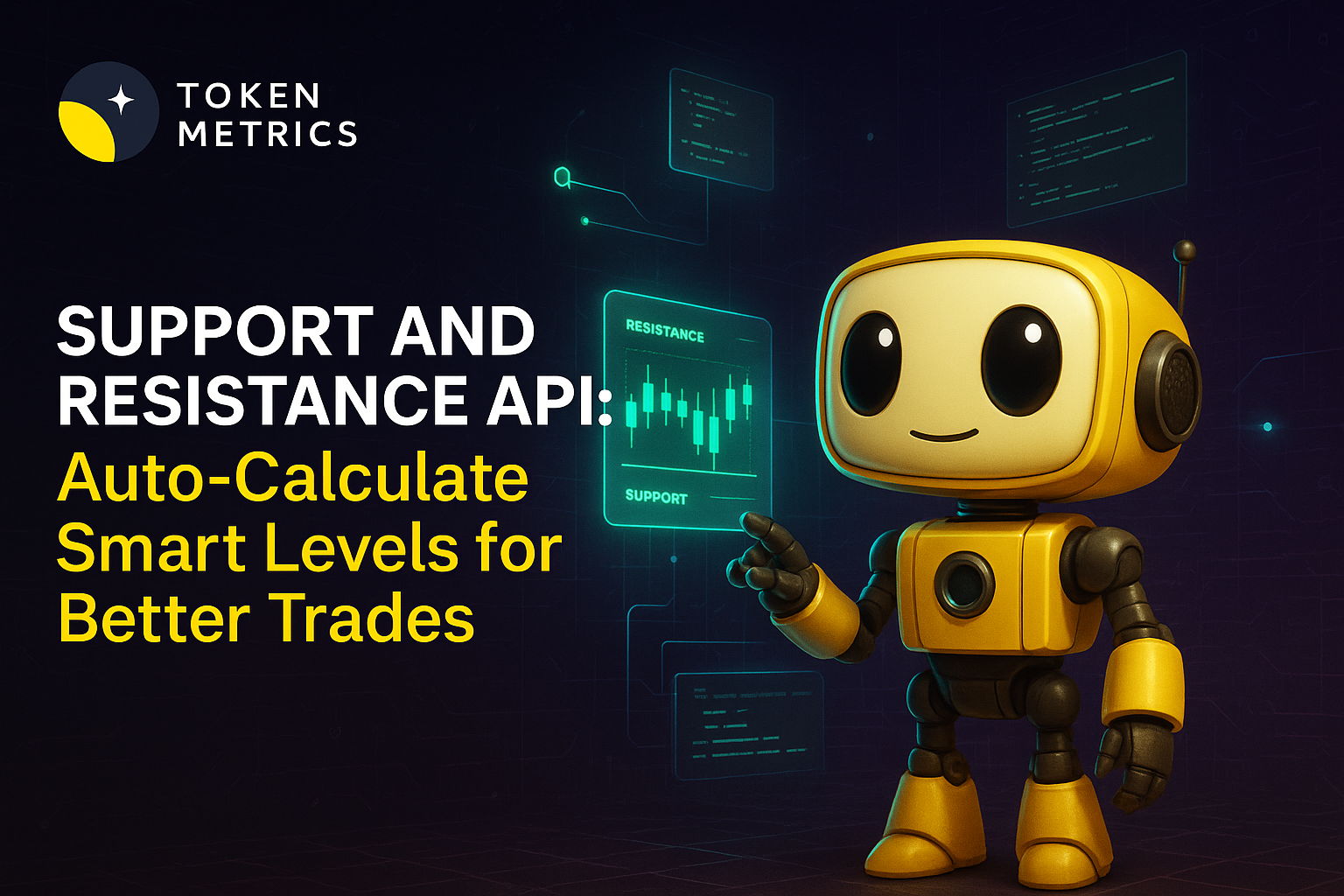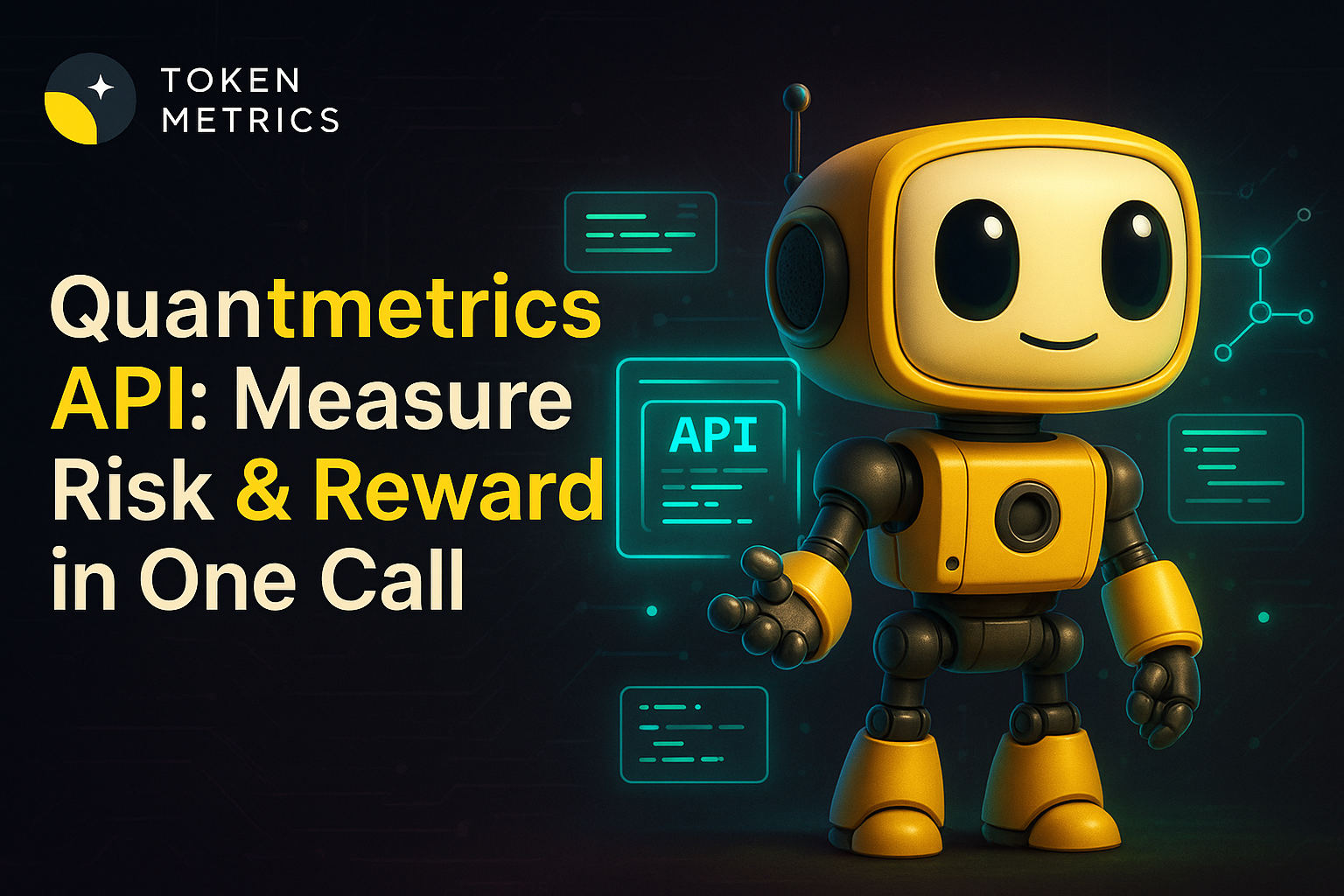Top Crypto Trading Platforms in 2025







%201.svg)
%201.svg)
Big news: We’re cranking up the heat on AI-driven crypto analytics with the launch of the Token Metrics API and our official SDK (Software Development Kit). This isn’t just an upgrade – it's a quantum leap, giving traders, hedge funds, developers, and institutions direct access to cutting-edge market intelligence, trading signals, and predictive analytics.
Crypto markets move fast, and having real-time, AI-powered insights can be the difference between catching the next big trend or getting left behind. Until now, traders and quants have been wrestling with scattered data, delayed reporting, and a lack of truly predictive analytics. Not anymore.
The Token Metrics API delivers 32+ high-performance endpoints packed with powerful AI-driven insights right into your lap, including:
Getting started with the Token Metrics API is simple:
At Token Metrics, we believe data should be decentralized, predictive, and actionable.
The Token Metrics API & SDK bring next-gen AI-powered crypto intelligence to anyone looking to trade smarter, build better, and stay ahead of the curve. With our official SDK, developers can plug these insights into their own trading bots, dashboards, and research tools – no need to reinvent the wheel.
%201.svg)
%201.svg)
Most traders still draw lines by hand in TradingView. The support and resistance API from Token Metrics auto-calculates clean support and resistance levels from one request, so your dashboard, bot, or alerts can react instantly. In minutes, you’ll call /v2/resistance-support, render actionable levels for any token, and wire them into stops, targets, or notifications. Start by grabbing your key on Get API Key, then Run Hello-TM and Clone a Template to ship a production-ready feature fast.
A minimal script that fetches Support/Resistance via /v2/resistance-support for a symbol (e.g., BTC, SOL).
Precision beats guesswork. Hand-drawn lines are subjective and slow. The support and resistance API standardizes levels across assets and timeframes, enabling deterministic stops and take-profits your users (and bots) can trust.
Production-ready by design. A simple REST shape, predictable latency, and clear semantics let you add levels to token pages, automate SL/TP alerts, and build rule-based execution with minimal glue code.
Need the Support and Resistance data? The cURL request for it is in the top right of the API Reference for quick access.
👉 Keep momentum: Get API Key • Run Hello-TM • Clone a Template
The Support/Resistance endpoint analyzes recent price structure to produce discrete levels above and below current price, along with strength indicators you can use for priority and styling. Query /v2/resistance-support?symbol=<ASSET>&timeframe=<HORIZON> to receive arrays of level objects and timestamps.
Polling vs webhooks. For dashboards, short-TTL caching and batched fetches keep pages snappy. For bots and alerts, use queued jobs or webhooks (where applicable) to avoid noisy, bursty polling—especially around market opens and major events.
A JSON payload with arrays of support and resistance levels for a symbol (and optional timeframe), each with a price and strength indicator, plus an update timestamp.
The endpoint targets predictable latency suitable for dashboards and alerts. Use short-TTL caching for UIs, and queued jobs or webhooks for alerting to smooth traffic.
Common patterns: alert when price is within X% of a level, touches a level, or breaks beyond with confirmation. Always make downstream actions idempotent and respect rate limits.
Yes—pair with /v2/trading-signals for timing, /v2/tm-grade for quality context, and /v2/quantmetrics for risk sizing. This yields a complete decide-plan-execute loop.
Intraday bots prefer shorter horizons; swing/position dashboards use daily or higher-timeframe levels. Offer a timeframe toggle and cache results per setting.
Use the REST snippets above (JS/Python). The docs include quickstarts, Postman collections, and templates—start with Run Hello-TM.
Begin free and scale as you grow. See API plans for rate limits and enterprise SLA options.
This content is for educational purposes only and does not constitute financial advice. Always conduct your own research before making any trading decisions.
%201.svg)
%201.svg)
Most traders see price—quants see probabilities. The Quantmetrics API turns raw performance into risk-adjusted stats like Sharpe, Sortino, volatility, drawdown, and CAGR so you can compare tokens objectively and build smarter bots and dashboards. In minutes, you’ll query /v2/quantmetrics, render a clear performance snapshot, and ship a feature that customers trust. Start by grabbing your key at Get API Key, Run Hello-TM to verify your first call, then Clone a Template to go live fast.
Risk-adjusted truth beats hype. Price alone hides tail risk and whipsaws. Quantmetrics compresses edge, risk, and consistency into metrics that travel across assets and timeframes—so you can rank universes, size positions, and communicate performance like a professional.
A clean REST schema, predictable latency, and easy auth mean you can plug Sharpe/Sortino into bots, dashboards, and screeners without maintaining your own analytics pipeline. Pair with caching and batching to serve fast pages at scale.
The Quant Metrics cURL request is located in the top right of the API Reference, allowing you to easily integrate it with your application.
Build Smarter Crypto Apps & AI Agents with Token Metrics
Token Metrics provides real-time prices, trading signals, and on-chain insights all from one powerful API. Grab a Free API Key
Quantmetrics computes risk-adjusted performance over a chosen lookback (e.g., 30d, 90d, 1y). You’ll receive a JSON snapshot with core statistics:
Call /v2/quantmetrics?symbol=<ASSET>&window=<LOOKBACK> to fetch the current snapshot. For dashboards spanning many tokens, batch symbols and apply short-TTL caching. If you generate alerts (e.g., “Sharpe crossed 1.5”), run a scheduled job and queue notifications to avoid bursty polling.
A JSON snapshot of risk-adjusted metrics (e.g., Sharpe, Sortino, volatility, max drawdown, CAGR) for a symbol and lookback window—ideal for ranking, sizing, and dashboards.
Responses are engineered for predictable latency. For heavy UI usage, add short-TTL caching and batch requests; for alerts, use scheduled jobs or webhooks where available.
Yes—many quants size inversely to volatility or require Sharpe ≥ X to trade. Always backtest and paper-trade before going live; past results are illustrative, not guarantees.
Short windows (30–90d) adapt faster but are noisier; longer windows (6–12m) are steadier but slower to react. Offer users a toggle and cache each window.
REST is straightforward (JS/Python above). Docs include quickstarts, Postman collections, and templates—start with Run Hello-TM.
Dashboards usually use cached polling. For threshold alerts (e.g., Sharpe crosses 1.0), run scheduled jobs and queue notifications to keep usage smooth and idempotent.
Begin free and scale up. See API plans for rate limits and enterprise SLA options.
All information provided in this blog is for educational purposes only. It is not intended as financial advice. Users should perform their own research and consult with licensed professionals before making any investment or trading decisions.
%201.svg)
%201.svg)
Timing makes or breaks every trade. The crypto trading signals API from Token Metrics lets you surface bullish and bearish calls directly in your product—no spreadsheet wrangling, no chart gymnastics. In this guide, you’ll hit the /v2/trading-signals endpoint, display actionable signals on a token (e.g., SOL, BTC, ETH), and ship a conversion-ready feature for bots, dashboards, or Discord. Start by creating a key on Get API Key, then Run Hello-TM and Clone a Template to go live fast.
Action over analysis paralysis. Traders don’t need more lines on a chart—they need an opinionated call they can automate. The trading signals API compresses technical momentum and regime reads into Bullish/Bearish events you can rank, alert on, and route into strategies.
Built for dev speed and reliability. A clean schema, predictable performance, and straightforward auth make it easy to wire signals into bots, dashboards, and community tools. Pair with short-TTL caching or webhooks to minimize polling and keep latency low.
You can find the cURL request for Crypto Trading Signals in the top right corner of the API Reference. Use it to access the latest signals!
Trading Signals distill model evidence (e.g., momentum regimes and pattern detections) into Bullish or Bearish calls with metadata such as confidence/score and timestamp. You request /v2/trading-signals?symbol=<ASSET> and render the most recent event, or a small history, in your UI.
For intraday workflows, use /v2/hourly-trading-signals to update positions or alerts more frequently. Dashboards typically use short-TTL caching or batched fetches; headless bots lean on webhooks, queues, or short polling with backoff to avoid spiky API usage.
A JSON payload with the latest Bullish/Bearish call for a symbol, typically including a confidence/score and generated_at timestamp. You can render the latest call or a recent history for context.
Signals are designed for timely, programmatic use with predictable latency. For faster cycles, use /v2/hourly-trading-signals. Add caching and queues/webhooks to reduce round-trips.
Yes—many developers do. A common pattern is: Signals → candidate entry, Support/Resistance → stop/targets, Quantmetrics → risk sizing. Always backtest and paper-trade before going live.
Backtests are illustrative, not guarantees. Treat signals as one input in a broader framework with risk controls. Evaluate hit rates and drawdowns on your universe/timeframe.
You can integrate via REST using JavaScript and Python snippets above. The docs include quickstarts, Postman collections, and templates—start with Run Hello-TM.
Dashboards often use cached polling. For bots/alerts, prefer webhooks or scheduled jobs and keep retries idempotent to avoid duplicate trades or messages.
Begin free and scale as you grow. See API plans for allowances; enterprise SLAs and support are available.
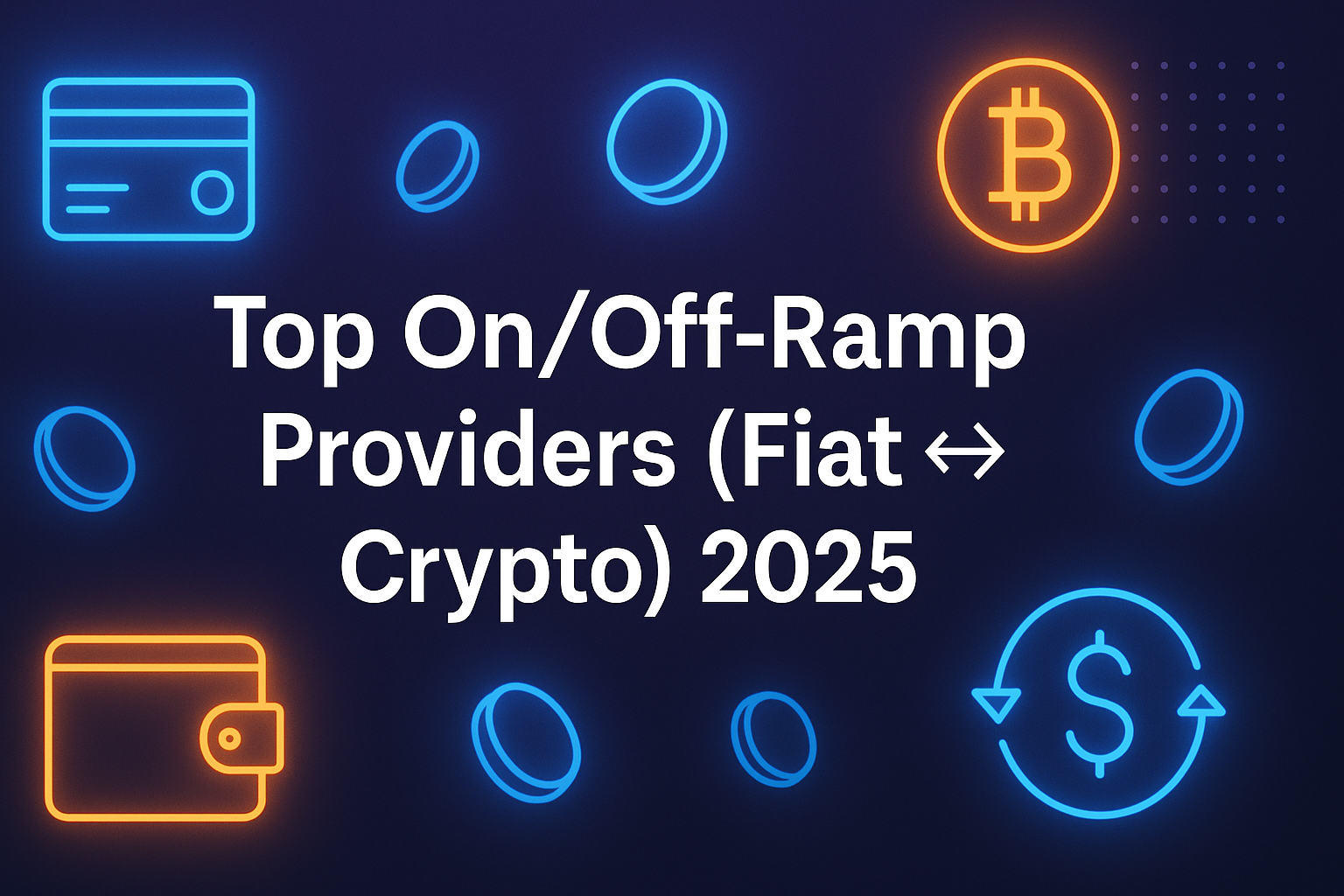
%201.svg)
%201.svg)
Getting money into and out of crypto should be fast, safe, and compliant. In 2025, wallets, dapps, exchanges, and fintechs increasingly rely on crypto on/off-ramp providers to convert fiat to tokens and cash back out to bank rails—all without forcing users to bounce between apps. Definition: an on-ramp lets users buy crypto with fiat; an off-ramp lets them sell crypto back to fiat and withdraw to bank accounts or cards. This guide is for product leaders, devs, and advanced users comparing coverage, fees, and risk controls across global options. We score providers on liquidity, security, asset/market coverage, costs, UX, and support, then recommend the best fits by use case. Secondary angles we considered: fiat to crypto onramp, crypto off-ramp, and common flows like “buy crypto with bank transfer.”
Data sources: official product/docs and security pages; licensing and disclosures; limited cross-checks with widely cited market datasets. We only link to official provider sites in this article. Last updated September 2025.
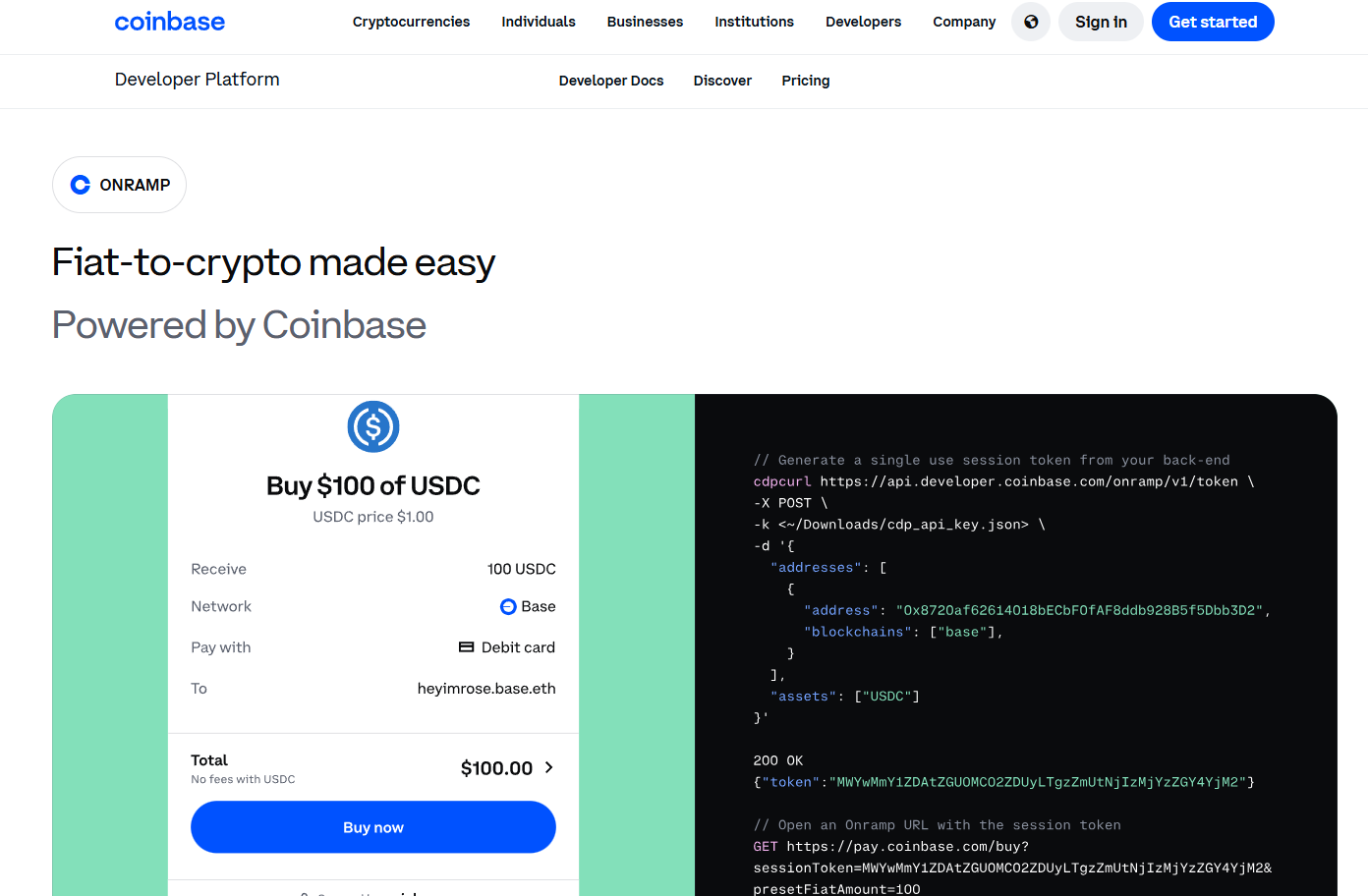
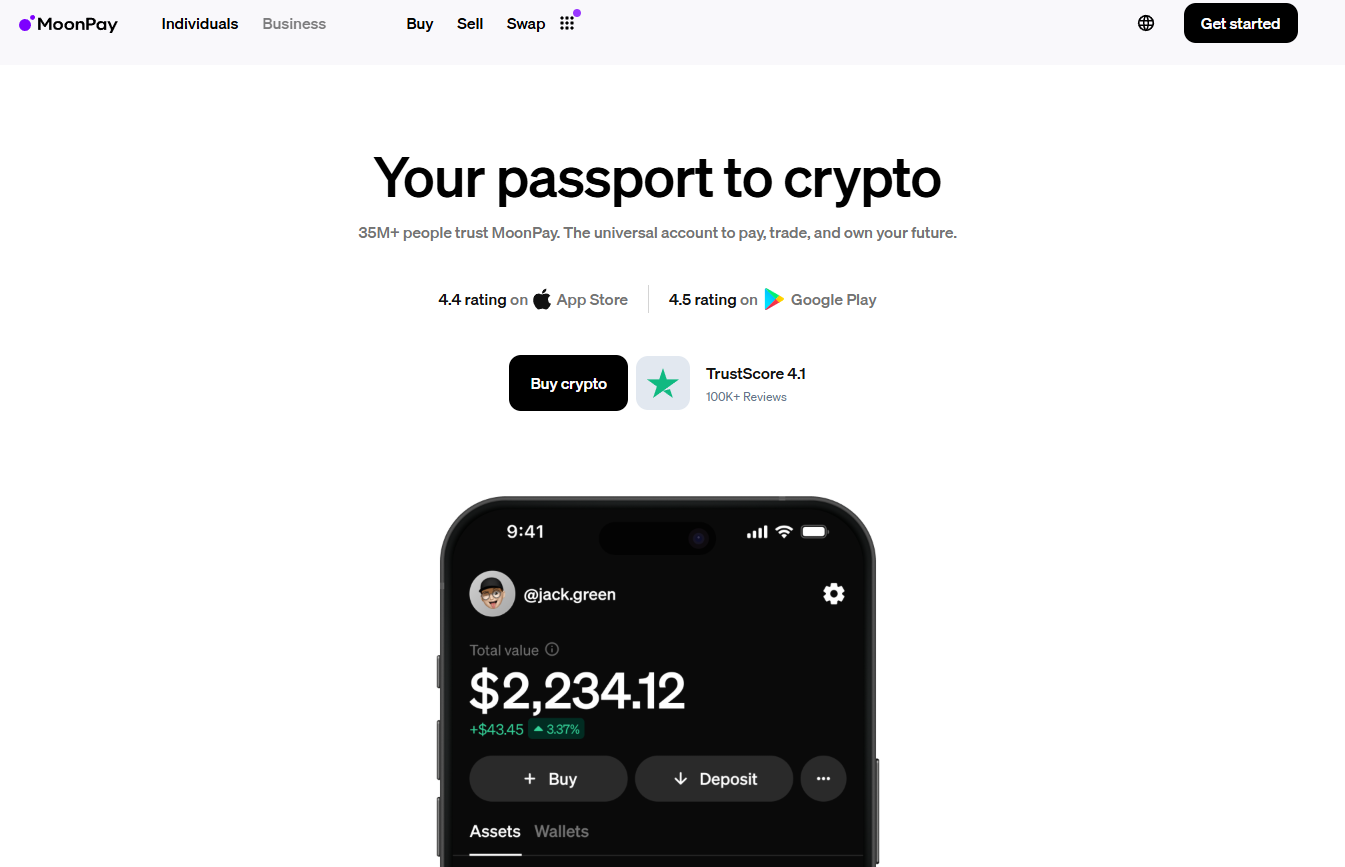
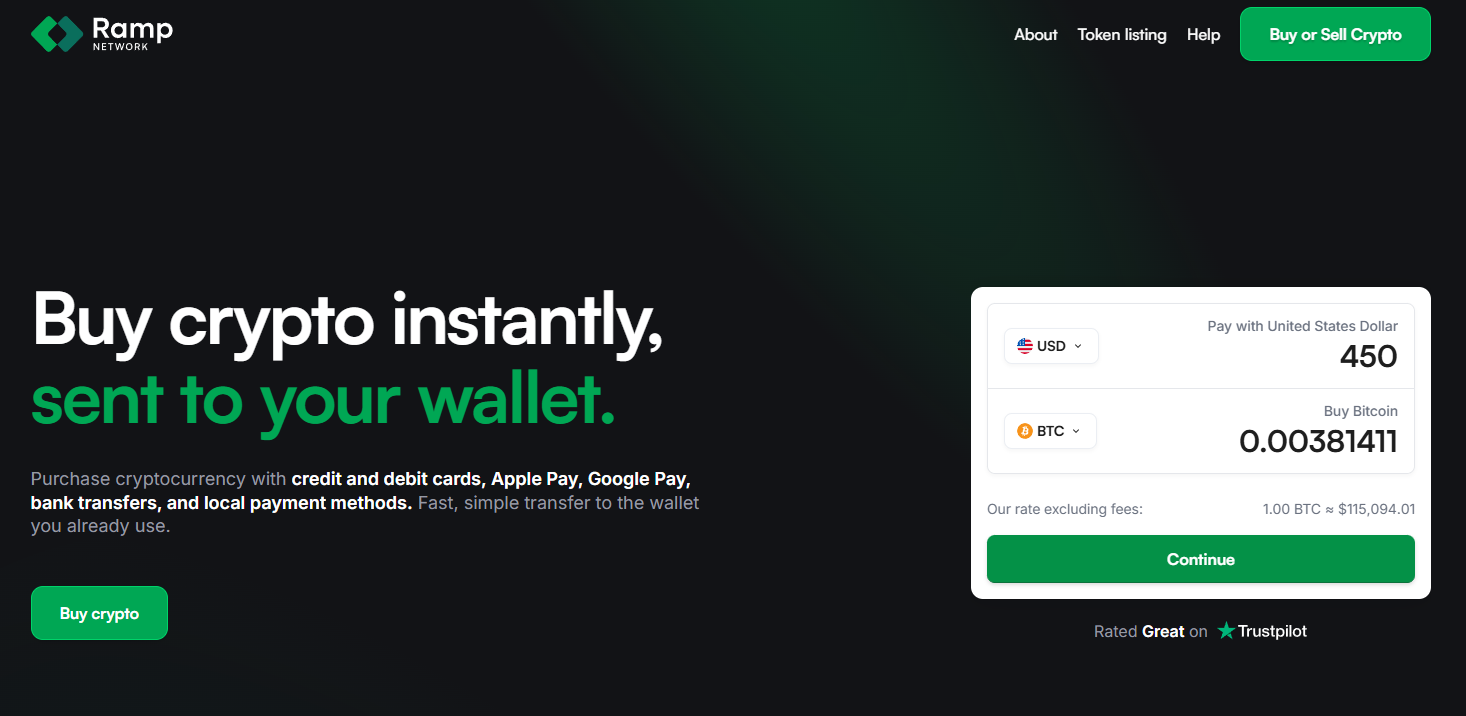

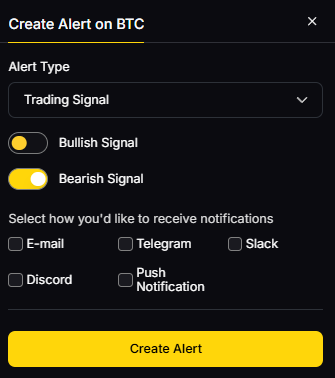
Primary CTA: Start free trial

This article is for research/education, not financial advice.
What is a crypto on-ramp vs. off-ramp?
An on-ramp lets users buy crypto with fiat (e.g., card, bank transfer). An off-ramp lets users sell crypto for fiat and withdraw to bank rails or cards. Coinbase
Which providers are best for U.S. ACH cashouts?
Coinbase Offramp and Kraken both support ACH, with method availability depending on state and account status. Coinbase Developer Docs+1
Does Stripe support off-ramp?
Stripe currently offers a fiat-to-crypto onramp (no off-ramp). It’s available in the U.S. (excluding Hawaii) and EU. Stripe Docs
Which options are strongest outside the U.S.?
For broad coverage and local rails, consider Ramp Network (Pix/SPEI), Transak (multi-network off-ramp), and Alchemy Pay (regional wallets). ramp.network+2Transak Docs+2
What about enterprise-grade compliance?
Banxa and Zero Hash publish license/compliance docs and are built for B2B integrations with higher assurance requirements. Banxa+1
The best choice depends on your region, payout rails, and risk posture. If you want a regulated U.S. ACH flow with strong docs, start with Coinbase. Need global coverage and local methods? Ramp, Transak, and Alchemy Pay shine. For enterprise and bank-grade requirements, Banxa and Zero Hash are strong bets. Exchange-based ramps via Kraken or Bitstamp work well if you also need deep liquidity.
Related Reads:
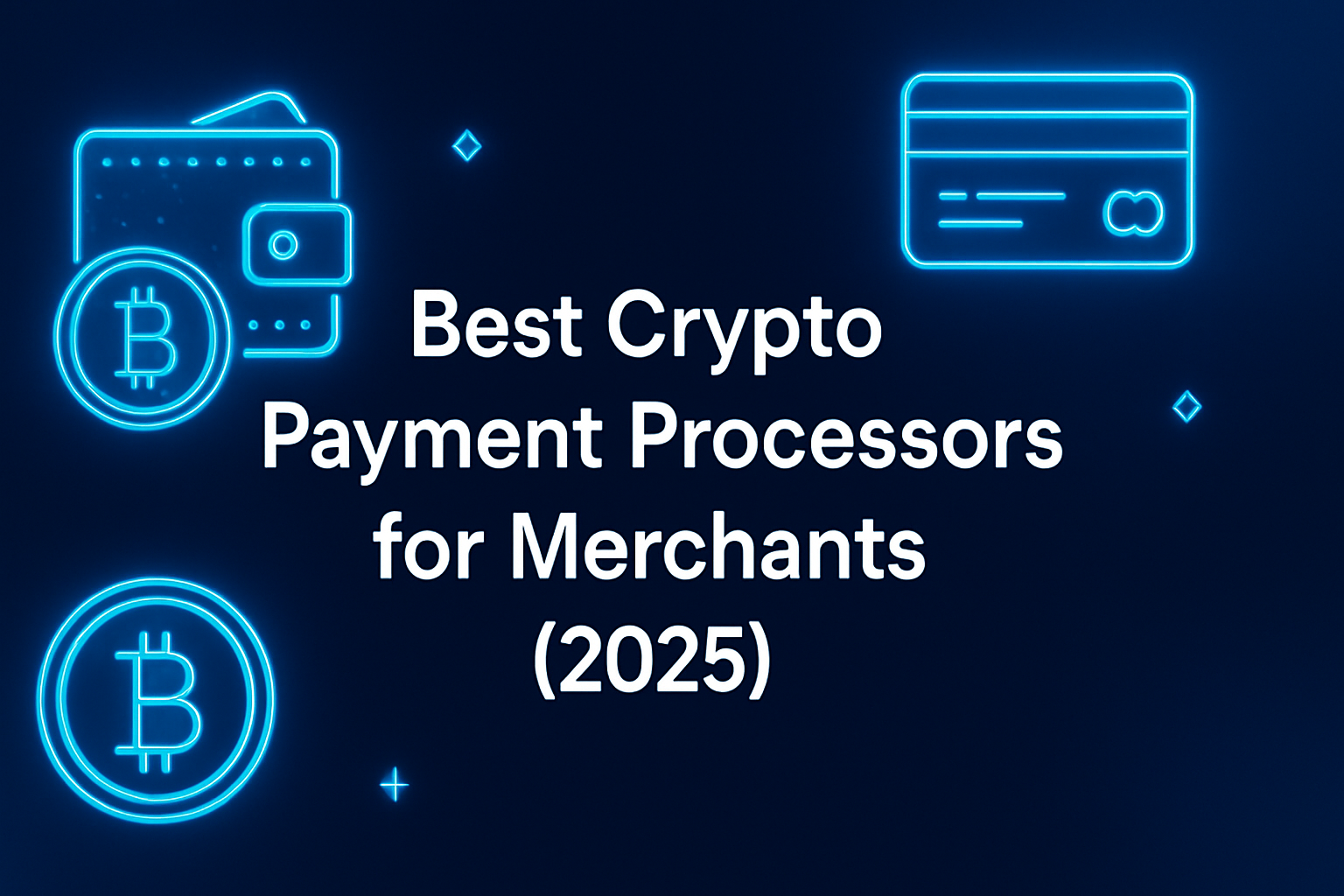
%201.svg)
%201.svg)
If you sell online (or in-store) and want to accept Bitcoin or stablecoins, choosing the best crypto payment processors can lower costs, expand global reach, and reduce chargeback risk. In one line: a crypto payment processor lets merchants accept digital assets at checkout and settle in crypto or fiat while handling pricing, invoicing, and compliance basics.
In 2025, stablecoin rails and Lightning are improving speed and costs, while major gateways add plugins for Shopify, WooCommerce, and custom APIs. This guide is for startups and enterprises comparing fees, settlement options, asset coverage, and regional availability. We blend live docs research with practical fit notes so you can pick confidently and ship faster.
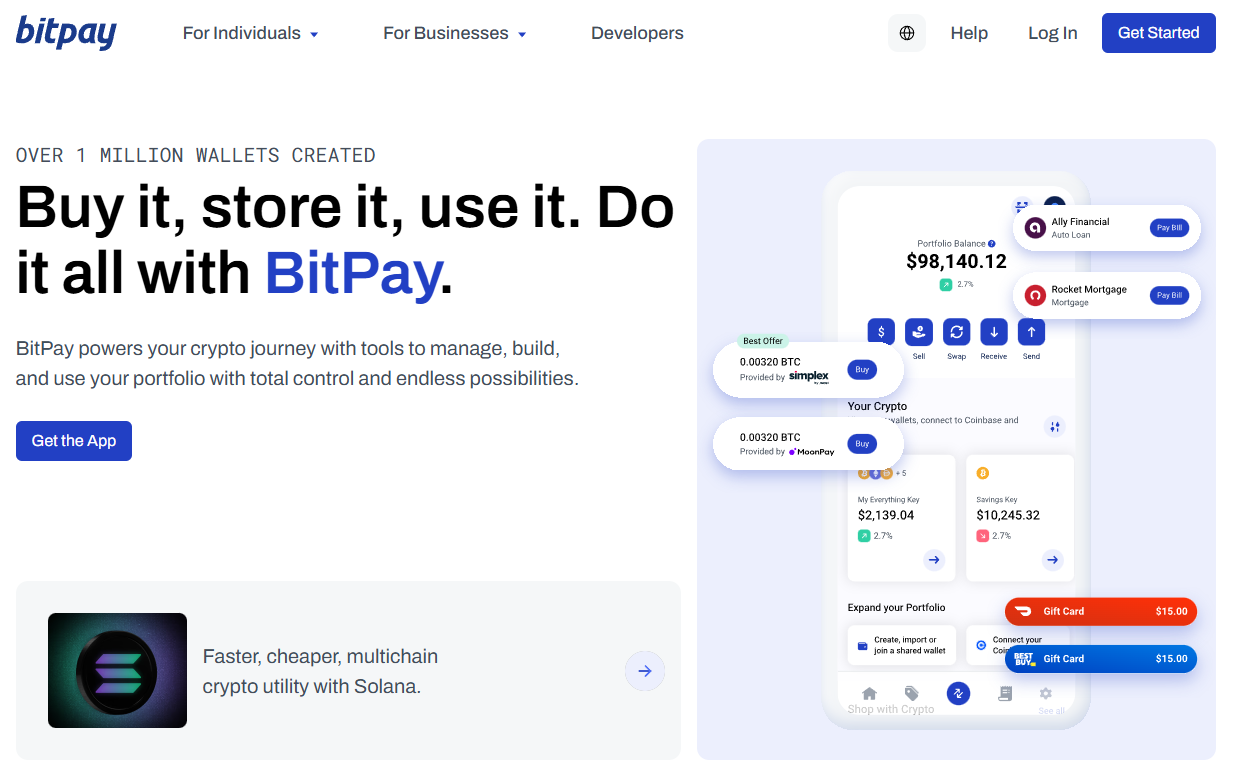
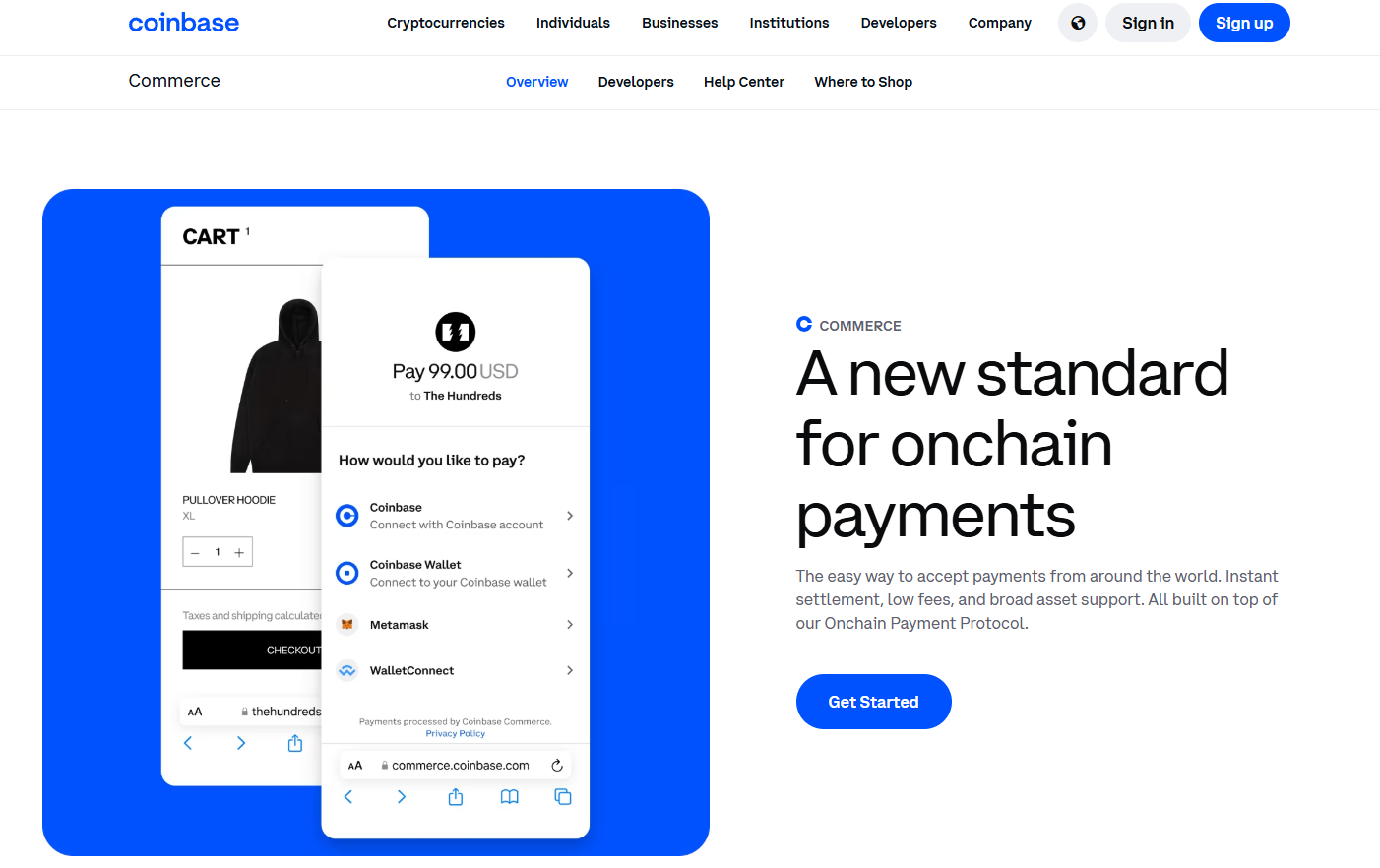
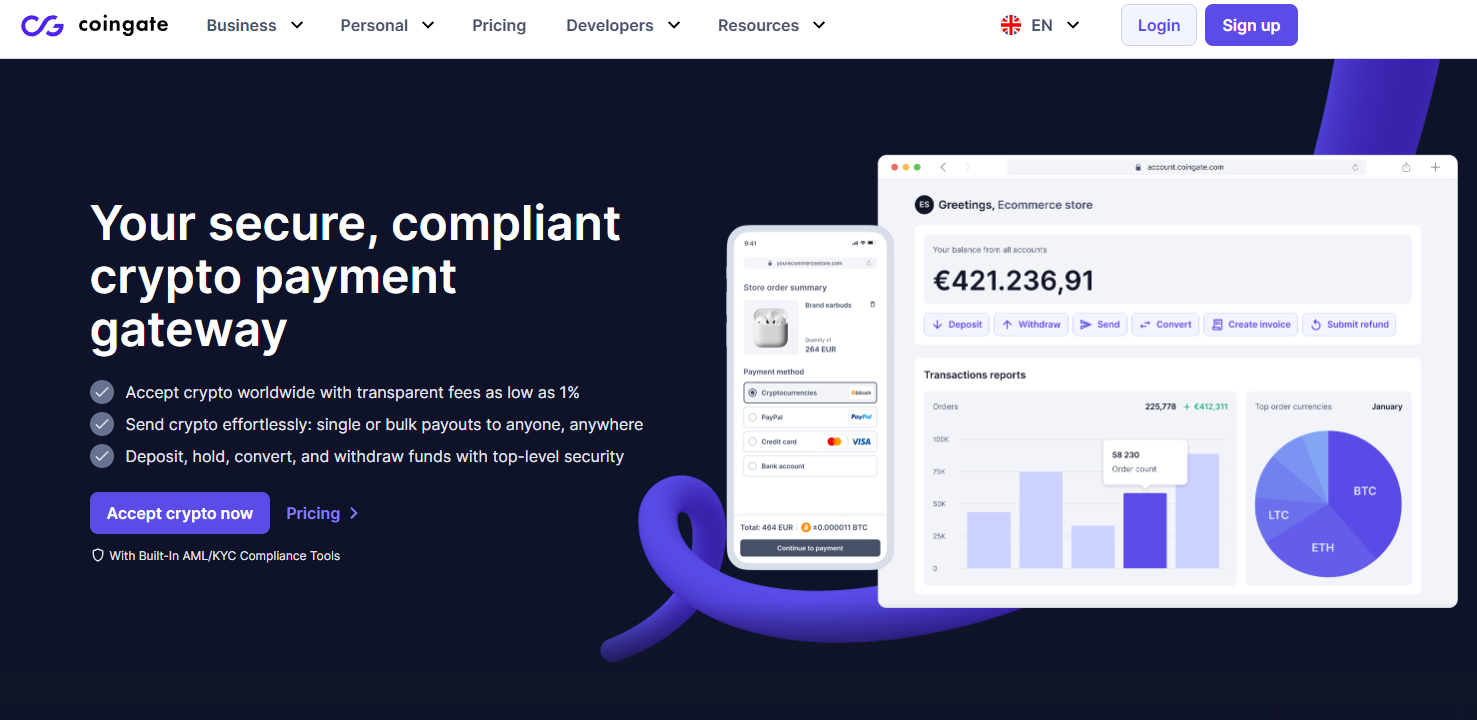

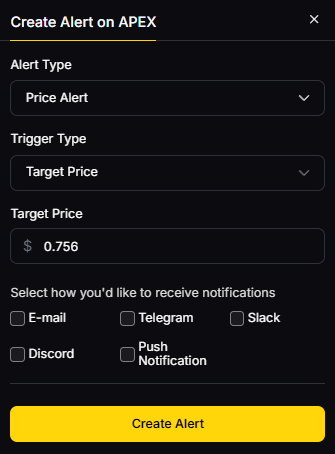
Primary CTA: Start free trial

This article is for research/education, not financial advice.
What is a crypto payment processor for merchants?
A service that lets businesses accept digital assets (e.g., BTC, USDC) and settle in crypto or fiat while handling pricing, invoicing, and basic compliance/reporting.
Are crypto fees lower than card fees?
Often yes—many gateways list ~0.5–1% base rates, though network and conversion/payout fees can apply. Compare total effective cost per order. Best Bitcoin & Crypto Payment Processor+2CoinPayments+2
Can I receive USD/EUR instead of crypto?
Most processors offer instant conversion and fiat settlement to bank accounts in supported regions. Check your vendor’s settlement currencies and schedules. OpenNode+1
Which is best for Lightning or micro-payments?
OpenNode and Lightspark are built around Lightning for instant, low-cost payments, with enterprise options and APIs. OpenNode+1
Is self-hosting a gateway possible?
Yes—projects like BTCPay Server exist for technical teams, but managed gateways reduce operational burden and add fiat settlement options.
Merchants should match checkout rails to customer demand: go BitPay/Coinbase Commerce for simplicity and brand trust, CoinGate/CoinPayments/NOWPayments for broad asset coverage, OpenNode/Lightspark for Lightning speed, and Alchemy Pay/Crypto.com Pay for hybrid rails and reach. Test fees and settlement with a pilot, then scale.
Related Reads:
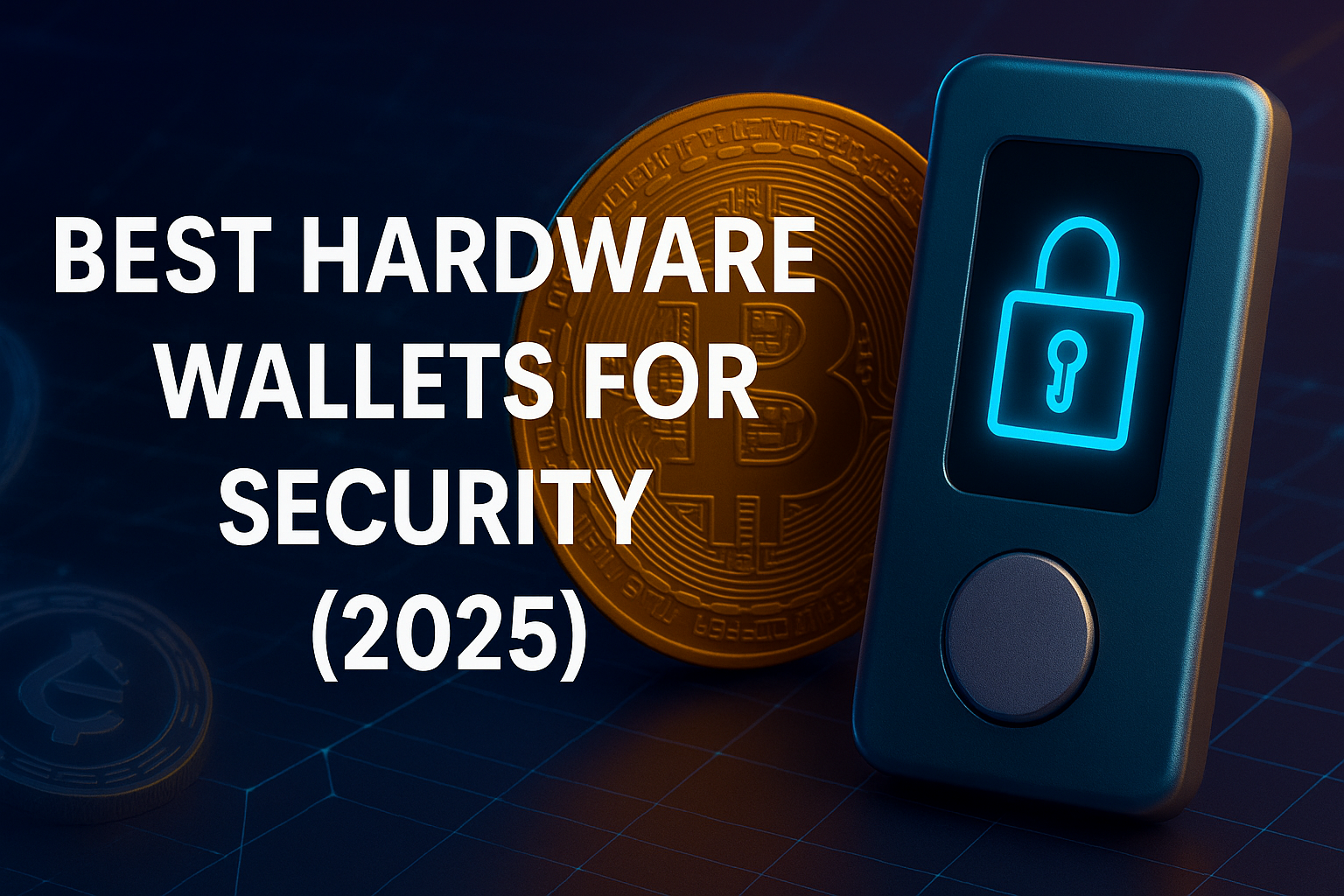
%201.svg)
%201.svg)
If you hold crypto, your keys are everything—and the best hardware wallets still offer the strongest defense against malware, phishing, and exchange failures. A hardware wallet is a dedicated, offline signing device that stores private keys and authorizes transactions without exposing secrets to the internet. In 2025, rising on-chain activity and more sophisticated wallet-drainer attacks make physical key management table stakes for both retail and pros.
This guide is for investors, traders, and builders who want maximum security without killing usability. We compare leading devices across security architecture, open-source posture, coin coverage, UX, and ecosystem readiness—so you can match the right wallet to your risk profile and stack. Secondary considerations include “crypto hardware wallet” setup flows, “cold wallet” signing paths, and “secure crypto wallet” recovery options.
We relied on official product and security pages, device docs, and transparency notes, using third-party market datasets only for cross-checks (no third-party links in body). Last updated September 2025.
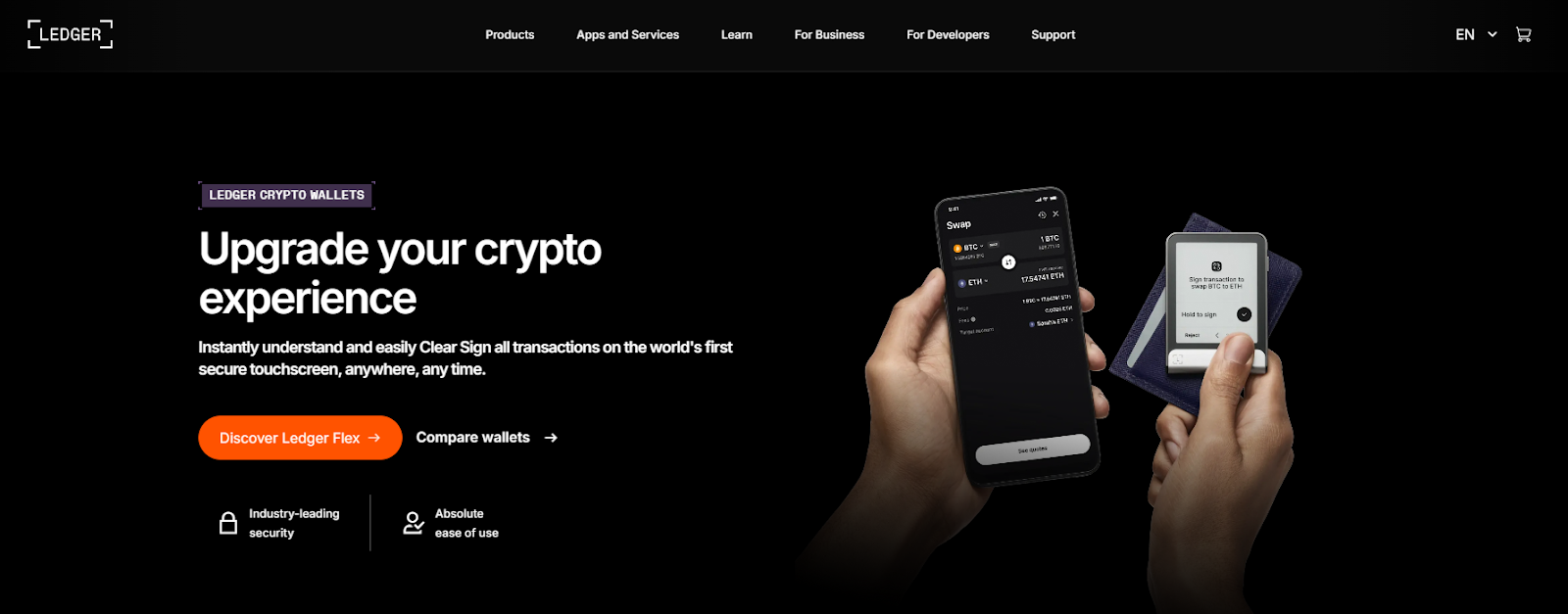

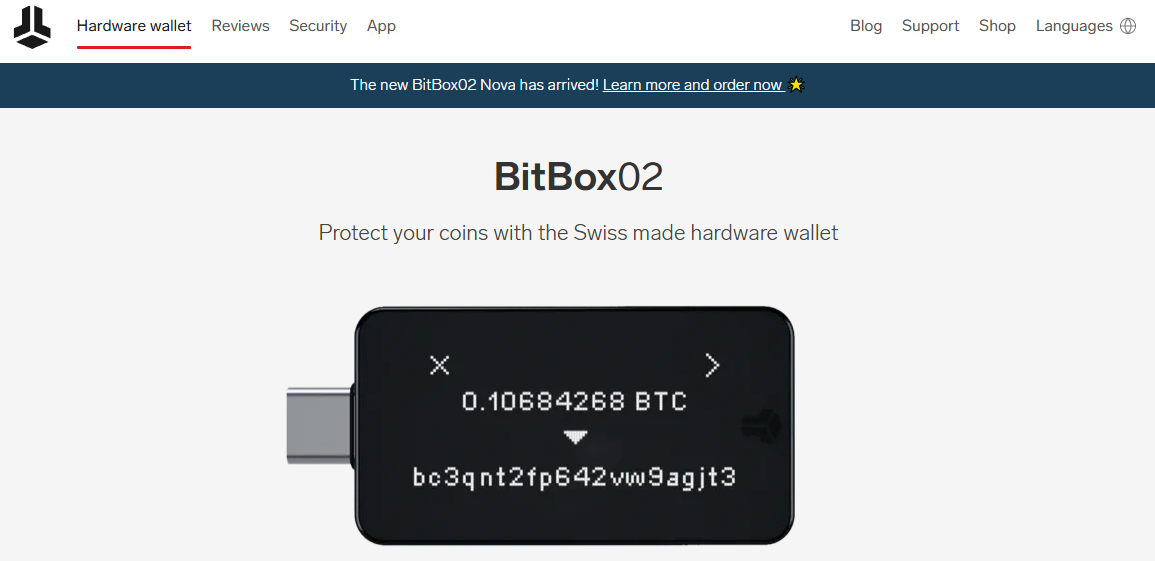
Turn cold storage into a smarter strategy:

Workflow: Research on Token Metrics → Pick assets → Acquire & secure with your wallet → Track performance + alerts.

Primary CTA: Start free trial

This article is for research/education, not financial advice.
What is a hardware wallet?
A hardware wallet is a physical device that stores private keys and authorizes transactions offline, reducing exposure to malware and phishing compared to software wallets.
Do I need a hardware wallet if I use a centralized exchange?
If an exchange is hacked or freezes withdrawals, you can lose access. A hardware wallet lets you self-custody, so you control keys and recovery—many users keep long-term holdings in cold storage and only move funds when needed.
Is a Secure Element required?
Not required, but many devices use a CC EAL5+/EAL6+ Secure Element to resist physical extraction. Open-source firmware and verifiable builds also matter—evaluate the whole model, not just one spec. Ledger
What’s the difference between air-gapped QR and USB/Bluetooth?
QR/PSBT keeps signing data offline via camera or microSD. USB/Bluetooth devices can still be safe if the secret keys never leave the secure chip and screens verify data—choose the flow you’ll actually use correctly. coldcard.com+1
Can I use one wallet for multiple chains?
Yes—multi-chain devices (e.g., Ledger, Trezor, Keystone) support many networks. Bitcoin-focused devices (COLDCARD, Passport, Jade) prioritize BTC security and workflows.
How often should I rotate or back up?
Back up at setup, test recovery once, and review backups quarterly. Rotate seeds if you suspect exposure, or after major life changes.
If you want the widest ecosystem, Ledger is tough to beat. Prefer open-source? Trezor or BitBox02 are excellent defaults. For Bitcoin vaulting, COLDCARD, Jade, or Passport shine. Need team or household management? Lattice1. Budget-friendly air-gap? SafePal. Seedless and ultra-portable? Tangem.
Pick a model you’ll use correctly—then let Token Metrics guide what goes inside it.
Related Reads:

%201.svg)
%201.svg)
Institutional custody is the backbone of professional digital-asset operations. The right institutional custody provider can safeguard private keys, segregate client assets, streamline settlement, and enable workflows like staking, financing, and governance. In one sentence: an institutional crypto custodian is a regulated organization that safekeeps private keys and operationalizes secure asset movements for professional clients. In 2025, rising ETF inflows, tokenization pilots, and on-chain settlement networks make safe storage and compliant operations non-negotiable. This guide is for funds, treasuries, brokers, and corporates evaluating digital asset custody partners across the US, EU, and APAC. We compare security posture, regulatory status (e.g., qualified custodian where applicable), asset coverage, fees, and enterprise UX—so you can shortlist fast and execute confidently.
Data sources: Official product/docs, trust/security pages, regulatory/licensing pages, and custodian legal/fee disclosures. Market size/sentiment cross-checked with widely cited datasets; we did not link third parties in-body.
Last updated September 2025.
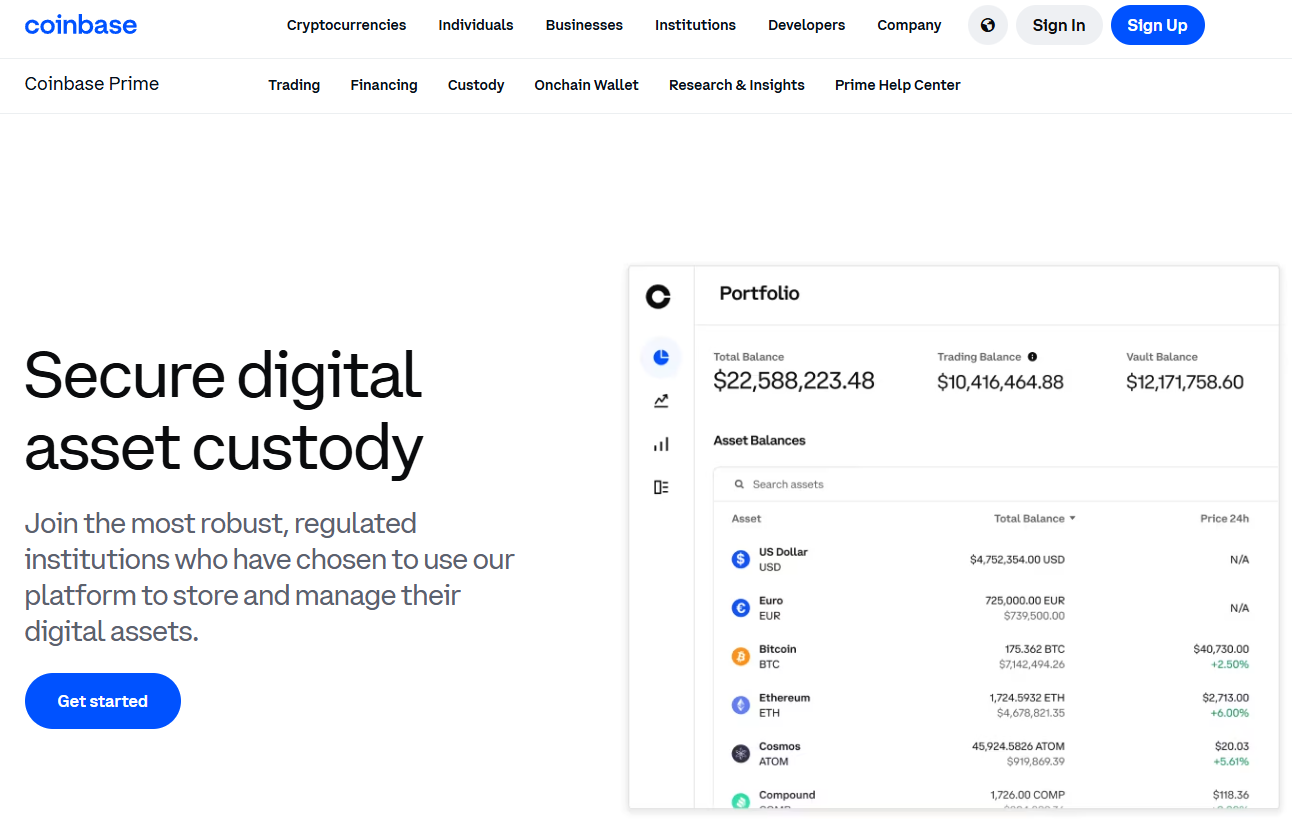
Why Use It: Coinbase Custody Trust Company is a NY state-chartered trust and qualified custodian, integrated with Prime trading, staking, and Web3 workflows. Institutions get segregated cold storage, SOC 1/2 audits, and policy-driven approvals within a mature prime stack. Coinbase+2Coinbase+2
Best For: US managers, ETF service providers, funds/treasuries that need deep liquidity + custody.
Notable Features:

Why Use It: A division of Fidelity with an integrated custody + execution stack designed for institutions, offering cold-storage execution without moving assets and traditional operational governance. Fidelity Digital Assets+1
Best For: Asset managers, pensions, corporates seeking a blue-chip brand and conservative controls.
Notable Features:
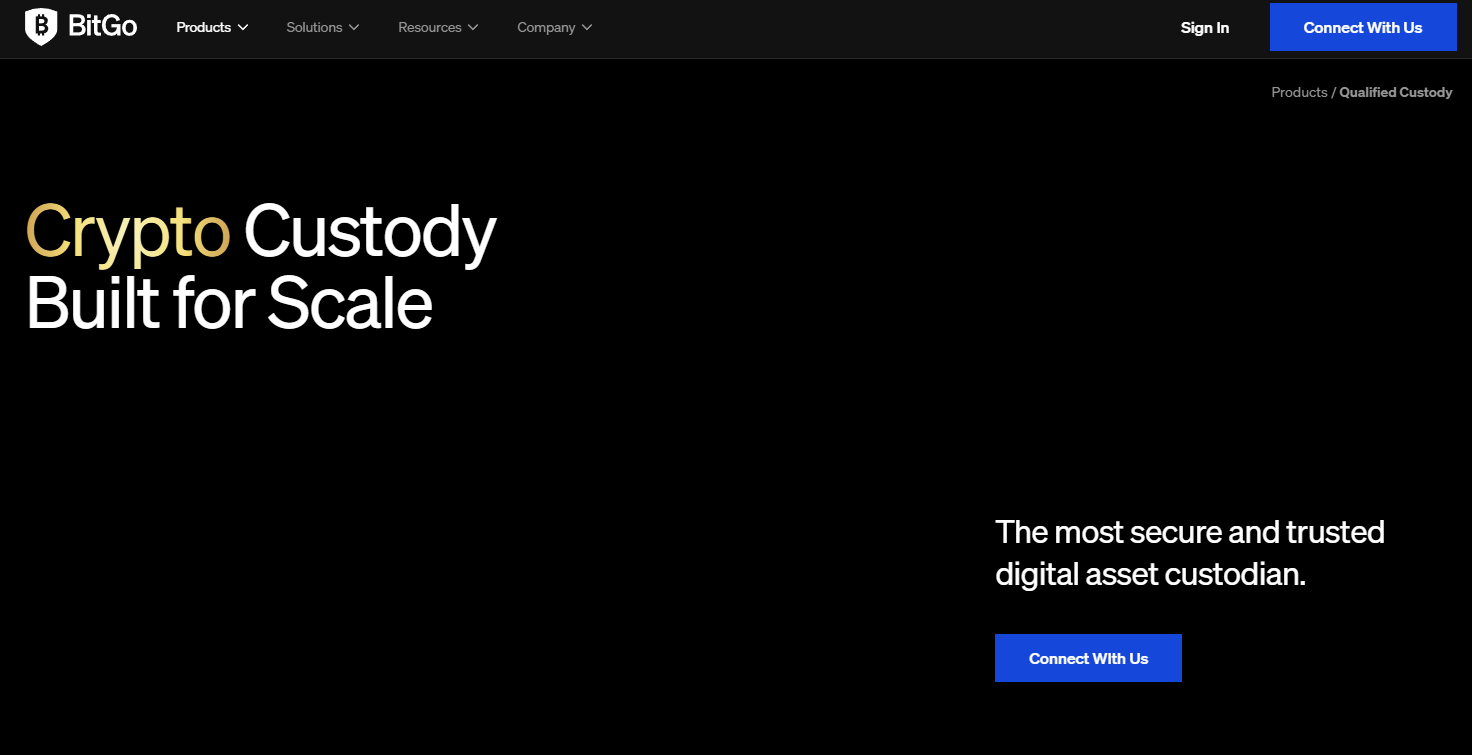
Why Use It: BitGo operates qualified custody entities with coverage across North America, EMEA, and APAC, plus robust policy controls and detailed billing methodology for AUC. The Digital Asset Infrastructure Company+1
Best For: Funds, market makers, and enterprises needing global entity flexibility.
Notable Features:
Why Use It: The only crypto-native bank with an OCC charter in the US; a qualified custodian with staking and governance alongside institutional custody. Anchorage+1
Best For: US institutions that want bank-level oversight and crypto-native tech.
Notable Features:
Why Use It: America’s oldest bank runs an institutional Digital Assets Platform for safekeeping and on-chain services, built on its global custody foundation—ideal for asset-servicing integrations. BNY+1
Best For: Asset servicers, traditional funds, and banks needing large-scale controls.
Notable Features:
Why Use It: Gemini Trust Company is a NY-chartered fiduciary and qualified custodian with air-gapped cold storage, role-based governance, and SOC reports—plus optional insurance coverage for certain assets. Gemini+1
Best For: Managers and corporates prioritizing conservative cold storage.
Notable Features:
Why Use It: Nomura-backed Komainu operates regulated custody with segregation and staking, supported by licenses/registrations across Jersey, the UAE (Dubai VARA), the UK, and Italy—useful for cross-border institutions. Komainu+1
Best For: Institutions needing EMEA/Middle East optionality and staking within custody.
Notable Features:
Why Use It: Backed by Standard Chartered, Zodia provides institutional custody with air-gapped cold storage, standardized controls, and licensing/registrations across the UK, Ireland, Luxembourg, and Abu Dhabi (ADGM). zodia-custody.com+1
Best For: Asset managers and treasuries seeking bank-affiliated custody in EMEA.
Notable Features:
Why Use It: FINMA-regulated Swiss bank providing off-balance-sheet crypto custody, staking, and Sygnum Connect—a 24/7 instant settlement network for fiat, crypto, and stablecoins. Sygnum Bank+1
Best For: EU/Asia institutions valuing Swiss regulation and bank-grade controls.
Notable Features:
Why Use It: A fully licensed APAC custodian offering on-chain segregation, role-segregated workflows, staking, and—in 2025—obtained a MAS Major Payment Institution license to offer DPT services in Singapore, rounding out custody + settlement. Hex Trust+1
Best For: Funds, foundations, and corporates across Hong Kong, Singapore, and the Middle East.
Notable Features:
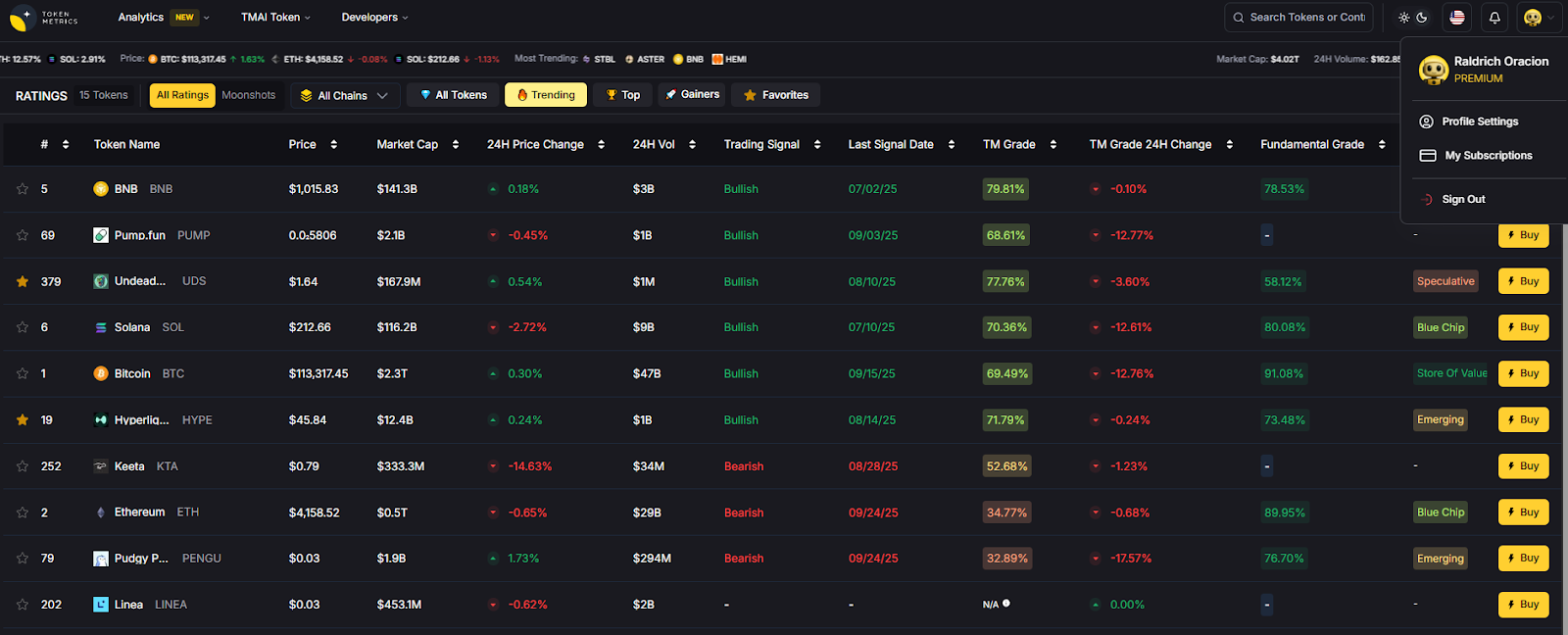

Primary CTA: Start free trial.

This article is for research/education, not financial advice.
What is a qualified custodian in crypto?
A qualified custodian is a regulated entity (e.g., trust company or bank) authorized to hold client assets with segregation and audited controls, often required for investment advisers. Look for clear disclosures, SOC reports, and trust/bank charters on official pages. Coinbase+1
Do I need a qualified custodian for my fund?
Many US advisers and institutions require qualified custody under their compliance frameworks; your legal counsel should confirm. When in doubt, choose a trust/bank chartered provider with documented segregation and audits. Coinbase
Which providers support staking from custody?
Anchorage, Coinbase Prime, Komainu, Sygnum, and Hex Trust offer staking workflows from custody (asset lists vary). Confirm asset-by-asset support and commissions. Hex Trust+4Anchorage+4Coinbase+4
How are fees structured?
Most providers price custody in annualized basis points (bps) on average assets under custody; some publish methodologies or fee schedules. Network fees are usually passed through. The Digital Asset Infrastructure Company
Can I keep assets off-exchange and still trade?
Yes—prime/custody integrations and instant-settlement networks let you trade while keeping keys in custody, reducing counterparty risk. Examples include Coinbase Prime and Sygnum Connect. Coinbase+1
Are there regional restrictions I should know about?
Licensing/availability varies (e.g., Hex Trust operates under MAS MPI in Singapore; Zodia holds permissions across UK/EU/ADGM). Always confirm eligibility for your entity and region. Hex Trust+1
If you operate in the US with strict compliance needs, start with Coinbase Prime, Fidelity, or Anchorage. For bank-backed EMEA coverage, look to BNY Mellon or Zodia. For Swiss banking controls and instant settlement, Sygnum stands out; in APAC, Hex Trust offers strong licensing and workflows. BitGo and Komainu excel when you need multi-jurisdiction flexibility.
Related Reads:
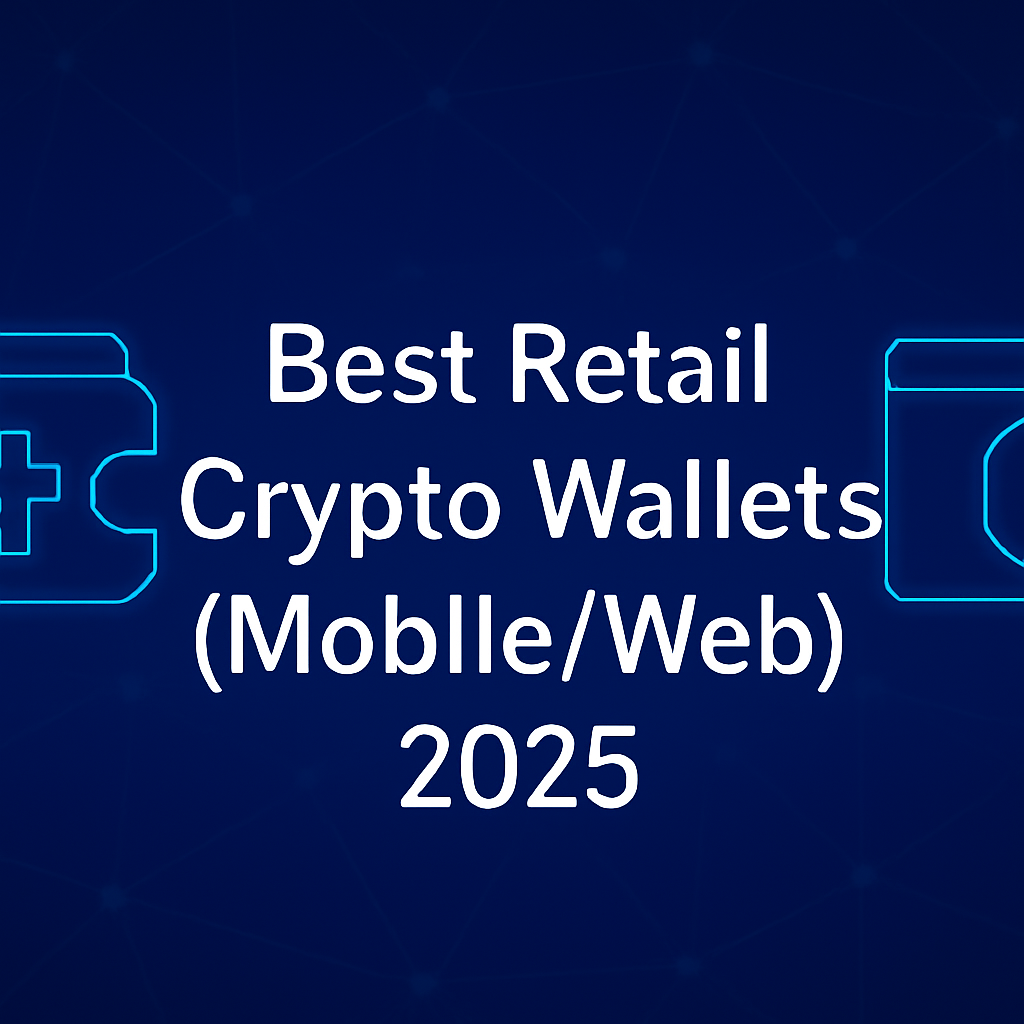
%201.svg)
%201.svg)
Retail-friendly mobile and web wallets make crypto usable—on your phone and in your browser—without relying on a centralized custodian. This guide ranks the best retail crypto wallets for 2025 so you can safely store, send, swap, and explore Web3. A crypto wallet is software that holds your keys and lets you sign transactions; self-custody means you control those keys.
We focus on practical needs: everyday buys, swaps, NFT viewing, multi-chain coverage, and clear fees. Expect mainstream names alongside rising multichain players. Secondary considerations include mobile crypto wallet UX, web3 wallet dapp access, and self-custody wallet security. If you’re new, start with a wallet that offers simple onboarding and robust recovery. If you’re advanced, look for pre-transaction risk checks, multichain swaps, and hardware support.

Why Use It: The most ubiquitous Web3 wallet, MetaMask balances power and familiarity. It’s everywhere dapps are, with mobile + browser extension, good network support, and strong swap/bridge routing in-app. Smart Transactions and built-in security alerts improve reliability for everyday users. MetaMask
Best For: EVM users, NFT collectors, L2 explorers, DeFi regulars.
Notable Features: Smart Transactions; Swaps/Bridge aggregator; MetaMask Learn; mobile + major browsers. MetaMask+1
Consider If: You want explicit fee transparency—MetaMask Swaps includes a 0.875% service fee (plus network gas). MetaMask Help Center
Alternatives: Trust Wallet, OKX Wallet.
Regions: Global.
Fees Notes: Network fees; MetaMask Swaps service fee 0.875%. MetaMask Help Center
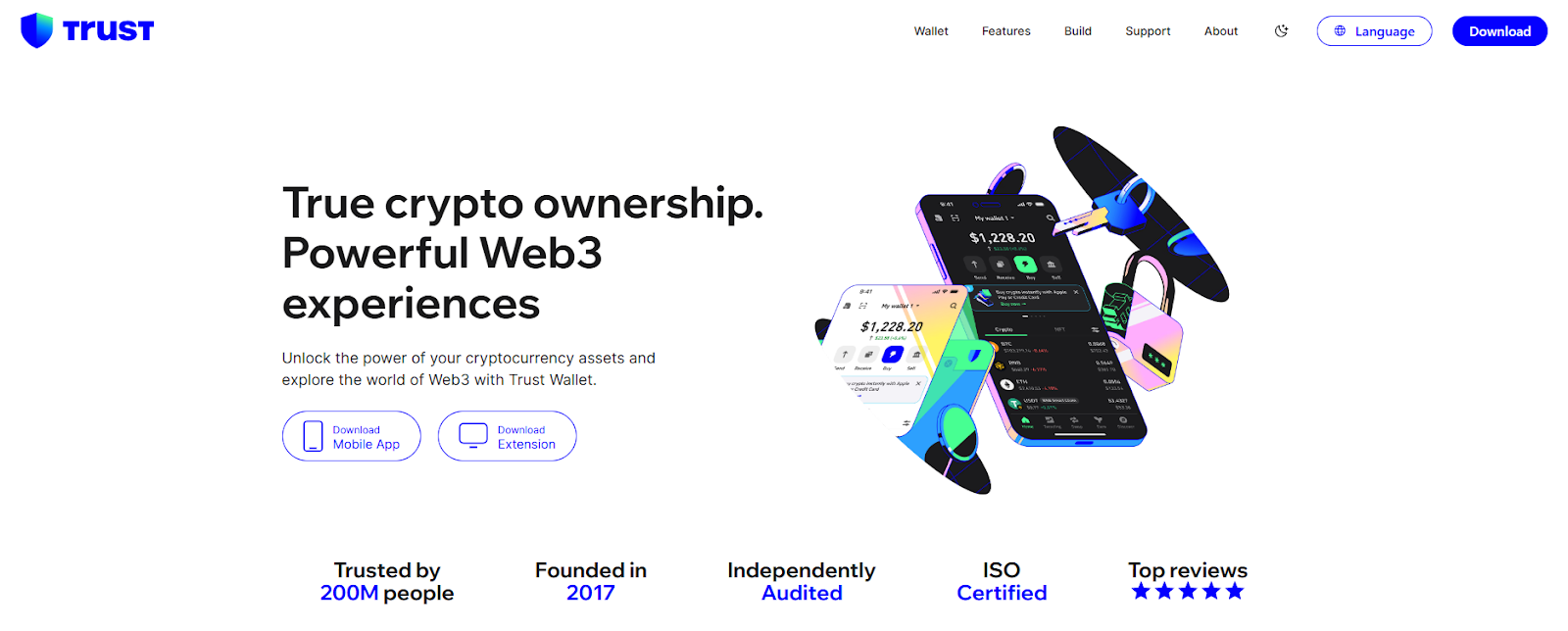
Why Use It: Trust Wallet offers a simple, one-stop experience: buy, send, swap, stake, and manage NFTs across many chains. Its mobile app is fast, and the extension integrates with popular EVM and non-EVM chains. Trust Wallet+1
Best For: Beginners who want breadth; multichain NFT holders; mobile-first users.
Notable Features: Built-in DApp browser; simplified swaps with gas optimization; staking flows. Trust Wallet
Consider If: You want no added swap fee—Trust says it doesn’t charge extra on swaps (you still pay network/third-party fees). Trust Wallet
Alternatives: MetaMask, Crypto.com Onchain.
Regions: Global.
Fees Notes: Network/partner fees apply; Trust states no added in-app swap fee. Trust Wallet
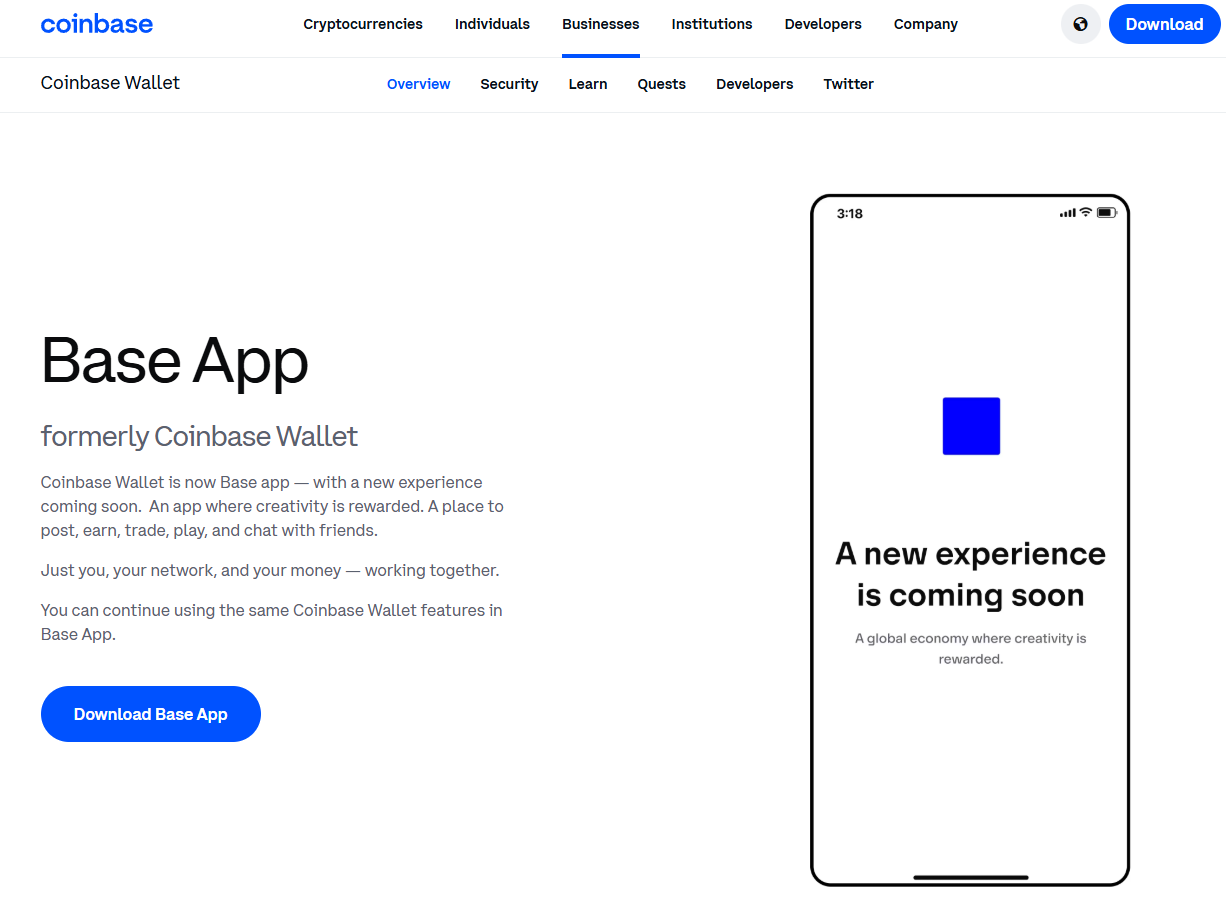
Why Use It: Rebranded as the Base app, the former Coinbase Wallet keeps familiar self-custody features while embracing Base/L2 culture and onchain social/activity. If you already use Coinbase products, onboarding is straightforward while staying self-custodial. Coinbase
Best For: Coinbase users going self-custody; Base/L2 explorers; web3 social/NFT dabblers.
Notable Features: Self-custody; trading, posting, playing; continuity for Coinbase Wallet users. Coinbase
Consider If: You prefer chain-agnostic advanced tooling—others may offer deeper multichain utilities today.
Alternatives: MetaMask, Rainbow.
Regions: Global.
Fees Notes: Network fees; third-party swap/partner fees where used. Coinbase
Why Use It: Phantom started Solana-first and has grown into a polished multichain wallet (Solana, Ethereum, and more). The interface is clean, with strong NFT views and transaction clarity—great for newcomers to Solana and cross-chain dabblers. Phantom+1
Best For: Solana users, NFT traders, multichain retail.
Notable Features: In-wallet swaps and bridging; gasless swaps on Solana (select cases); robust notifications/history. Phantom Support+1
Consider If: You want the lowest possible swap fees—Phantom lists 0.85% on select pairs, with separate gas/bridge fees. Phantom Support
Alternatives: OKX Wallet, Trust Wallet.
Regions: Global.
Fees Notes: Network fees; Phantom fee 0.85% on select swaps; gasless-swap fee rules apply on Solana. Phantom Support+1
Why Use It: OKX Wallet (extension + mobile) plugs you into OKX’s DEX aggregator, NFT marketplace, and DeFi. It offers multiple swap modes and solid routing—useful when chasing best execution across chains. OKX Wallet+1
Best For: DeFi users seeking liquidity routing; cross-chain swappers; NFT traders.
Notable Features: Multi-mode swaps; DEX aggregator; marketplace; Earn/Discover sections. OKX Wallet
Consider If: You need crystal-clear fee schedules—OKX lists DEX interface fee tiers up to 0.85% depending on pair groups. OKX Wallet
Alternatives: MetaMask, Bitget Wallet.
Regions: Global (wallet).
Fees Notes: Network fees; OKX DEX interface fee 0–0.85% by pair category. OKX Wallet
Why Use It: Exodus is a long-standing, self-custodial wallet with a beautifully designed UI across desktop and mobile. Portfolio tracking and NFT galleries are polished, and its Web3 Wallet extends multichain support. Exodus
Best For: Newcomers who want clarity; portfolio-first users; multi-device use.
Notable Features: Multichain Web3 Wallet; thousands of swap pairs; simple buy/sell integrations. Exodus
Consider If: You want explicit fee details—Exodus doesn’t charge send/receive wallet fees, but network and partner fees still apply. Exodus Knowledge Base
Alternatives: Crypto.com Onchain, ZenGo.
Regions: Global.
Fees Notes: No Exodus send/receive fees; network fees + third-party swap/fiat fees may apply. Exodus Knowledge Base
Why Use It: Formerly known as the DeFi Wallet experience, Crypto.com Onchain is a self-custodial app with multichain support, in-wallet trading, and dapp access. It’s friendly for users who like Crypto.com’s ecosystem but want self-custody keys. Crypto.com
Best For: Mobile-first users; staking/earn explorers; Crypto.com ecosystem fans.
Notable Features: Local key encryption; import via 12/18/24-word phrases; multichain trading & dapp browser. Crypto.com
Consider If: You prefer a purely chain-agnostic wallet without exchange brand ties—others may feel “lighter.”
Alternatives: Trust Wallet, Exodus.
Regions: Global (feature availability can vary).
Fees Notes: Network/partner fees; self-custody (no custodial withdrawal fees). Crypto.com
Why Use It: ZenGo uses MPC to remove single-point seed phrase risks while keeping you in self-custody. That makes setup and recovery less nerve-wracking for new users, without buying hardware. Zengo+1
Best For: Beginners prioritizing recovery; mobile-only users; security-conscious travelers.
Notable Features: Seed-phrase-free MPC; in-app buy/swap; staking for select assets. Zengo+1
Consider If: You want classic seed control or advanced on-chain tooling—some power features are simpler by design.
Alternatives: Ledger Live (with hardware), Trust Wallet.
Regions: Global.
Fees Notes: Network fees; partner fees for buy/swap as quoted in-app. Zengo
Why Use It: Formerly BitKeep, Bitget Wallet has grown into a large multichain wallet with DEX aggregation, dapp discovery, and memecoin-friendly flows. It’s geared for on-chain traders who want routing and token coverage across 65+ chains. Bitget Wallet+1
Best For: Power users in DeFi; memecoin and airdrop participants; cross-chain swaps.
Notable Features: Multichain DEX aggregator; dapp hub; iOS/Android + Chrome extension. Bitget Wallet
Consider If: You prefer a simpler, beginner-first interface—others above are more hand-holding.
Alternatives: OKX Wallet, MetaMask.
Regions: Global.
Fees Notes: Network fees; interface/partner fees vary by route/pair. Bitget Wallet
Why Use It: Ledger Live is the companion app to Ledger hardware wallets; it brings buy, swap, stake, and portfolio monitoring into a single interface while private keys stay in the hardware device. Great for retail users who want a mobile/desktop app but insist on offline signing. Ledger
Best For: Long-term holders; high-value accounts; users planning to add hardware.
Notable Features: Buy/sell/swap/stake modules; multi-asset support; iOS/Android + desktop. Google Play+1
Consider If: You don’t own hardware—full security benefits require a Ledger device.
Alternatives: ZenGo (MPC), Trezor Suite (with hardware).
Regions: Global.
Fees Notes: Network fees; partner fees for buy/swap as quoted in-app. Ledger


Primary CTA: Start free trial

This article is for research/education, not financial advice.
What is a retail crypto wallet (mobile/web)?
A mobile/web retail wallet is software that stores your private keys and lets you sign transactions from your phone or browser. Most are self-custodial, meaning you—not an exchange—control your keys.
Is a self-custody wallet safer than keeping coins on an exchange?
Self-custody removes exchange counterparty risk. However, you must protect recovery methods (seed phrase, MPC recovery) and your device. Hardware or MPC-based options can add protection.
Which wallet is best for beginners?
For simplicity: Trust Wallet, Exodus, or ZenGo. They have straightforward onboarding, clear portfolio views, and solid docs. Advanced users might prefer MetaMask, Phantom, or OKX Wallet for deeper on-chain tooling. OKX Wallet+5Trust Wallet+5Exodus+5
What fees should I expect?
You’ll always pay network gas. Some wallets add interface/service fees on swaps/bridges (e.g., MetaMask 0.875%; Phantom 0.85% on select pairs; OKX DEX 0–0.85% depending on token groups). MetaMask Help Center+2Phantom Support+2
Do I need hardware for mobile/web wallets?
No. Many work fine without hardware. For higher balances, pairing a mobile/web app with a hardware wallet (e.g., via Ledger Live) can reduce signing risk. Ledger
Can I use one wallet across multiple chains?
Yes—most featured wallets are multichain. Check chain lists and NFT support before migrating. OKX Wallet+2Bitget Wallet+2
If you want maximum dapp coverage, go MetaMask; Solana-centric with great UX, pick Phantom; for exchange-adjacent simplicity, choose Base app or Crypto.com Onchain; for hardware-backed security, Ledger Live. Power users chasing routing and airdrops may prefer OKX Wallet or Bitget Wallet, while newcomers should consider Trust Wallet, Exodus, or ZenGo.
Related Reads:
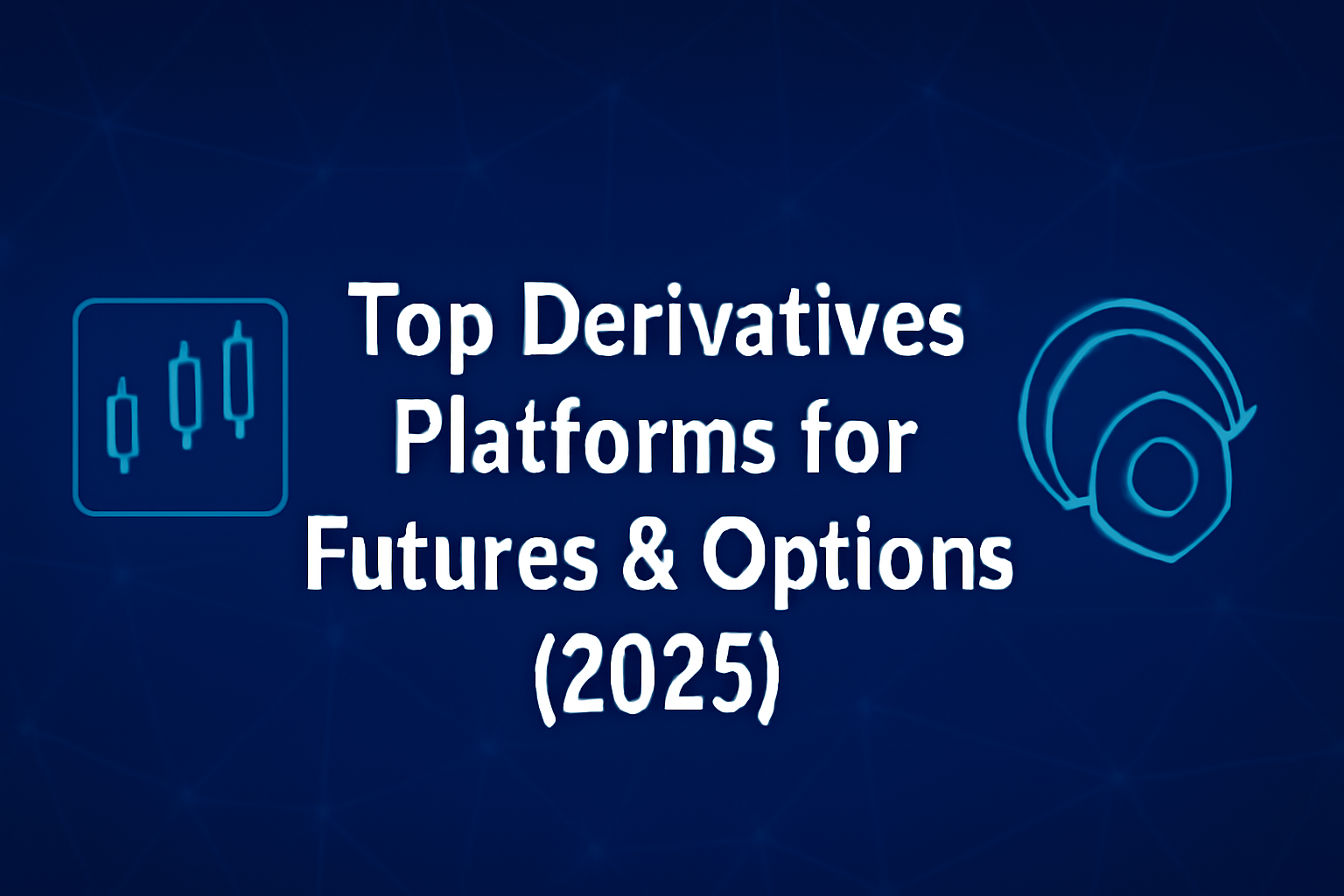
%201.svg)
%201.svg)
If you trade crypto futures and options, picking the right derivatives platforms can make or break your results. In this guide, we sort the top exchanges and on-chain venues by liquidity, security, costs, and product depth so you can match your strategy to the right venue—fast. You’ll find quick answers near the top, deeper context below, and links to official resources. We cover crypto futures, crypto options, and perpetual swaps for both centralized and decentralized platforms.
Quick answer: The best platform for you depends on region/eligibility, contract types (perps, dated futures, options), fee structure, margin system, and support quality. Below we score each provider and map them to common use cases.
We scored each provider using the weights below (0–100 total):
Sources: Official platform pages, help centers, and product docs; public disclosures and product catalogs; our hands-on review and long-term coverage of derivatives venues. Last updated September 2025.
Each summary includes why it stands out, who it’s best for, and what to consider. Always check regional eligibility.

Why Use It: Binance Futures offers some of the deepest books and widest perp listings, with robust APIs and portfolio margin. It’s a go-to for active traders who need speed and breadth.
Best For: High-frequency/active traders; systematic/API users; altcoin perp explorers.
Notable Features: Perpetuals and dated futures, options module, copy trading, portfolio margin.
Consider If: You need U.S.-regulated access—availability may vary by region.
Alternatives: OKX, Bybit.
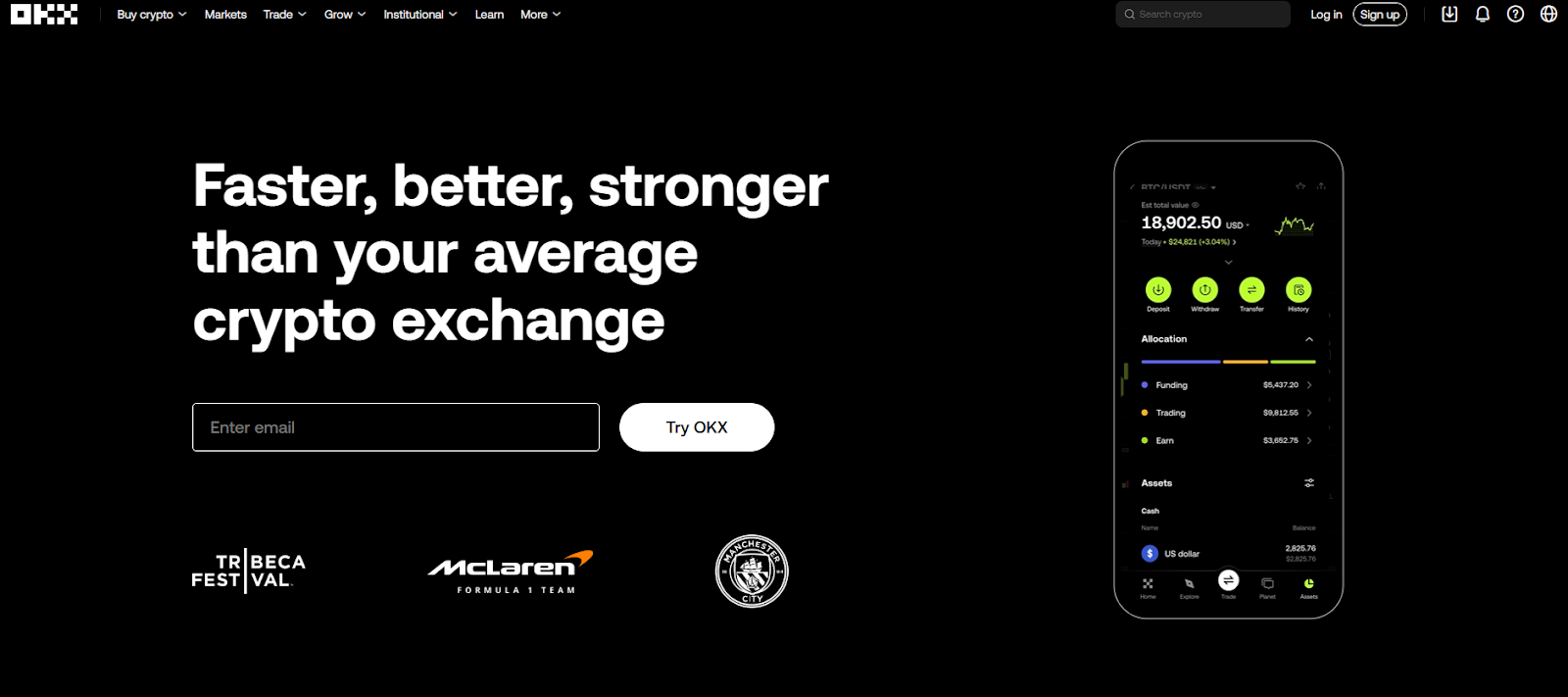
Why Use It: Strong product coverage (perps, dated futures, options) with solid liquidity and a polished interface. Good balance of features for discretionary and API traders.
Best For: Multi-instrument traders; users wanting options + perps under one roof.
Notable Features: Unified account, options chain, pre-market perps, apps and API.
Consider If: Region/eligibility and KYC rules may limit access.
Alternatives: Binance Futures, Bybit.

Why Use It: Competitive fees, broad perp markets, solid tooling, and a large user base make Bybit attractive for day traders and swing traders alike.
Best For: Perps power users; copy-trading and mobile-first traders.
Notable Features: USDT/USDC coin-margined perps, options, demo trading, OpenAPI.
Consider If: Check your local rules—service availability varies by region.
Alternatives: Binance Futures, Bitget.
Why Use It: Deribit is the reference venue for crypto options on BTC and ETH, with deep liquidity across maturities and strikes; it also offers futures.
Best For: Options traders (directional, spreads, volatility) and institutions.
Notable Features: Options analytics, block trading tools, test environment, 24/7 support.
Consider If: Regional access may be limited; primarily majors vs. broad alt coverage.
Alternatives: Aevo (on-chain), CME (regulated futures/options).
Why Use It: For institutions needing CFTC-regulated access, margin efficiency, and robust market infrastructure, CME is the standard for BTC/ETH futures and options.
Best For: Funds, corporates, and professionals with FCM relationships.
Notable Features: Standard and micro contracts, options, benchmarks, data tools.
Consider If: Requires brokerage/FCM onboarding; no altcoin perps.
Alternatives: Coinbase Derivatives (U.S.), Kraken Futures (institutions).
Why Use It: dYdX v4 runs on its own chain with on-chain settlement and pro tooling. Traders who want non-custodial perps and transparent mechanics gravitate here.
Best For: DeFi-native traders; users prioritizing self-custody and transparency.
Notable Features: On-chain orderbook, staking & trading rewards, API, incentives.
Consider If: Wallet/key management and gas/network dynamics add complexity.
Alternatives: Aevo (options + perps), GMX (alt DEX perps).
Why Use It: Kraken offers crypto futures for eligible regions, with a growing U.S. footprint via Kraken Derivatives US and established institutional services.
Best For: Traders who value brand trust, support, and clear documentation.
Notable Features: Pro interface, institutional onboarding, status and support resources.
Consider If: Product scope and leverage limits can differ by jurisdiction.
Alternatives: Coinbase Derivatives, CME.
Why Use It: NFA-supervised futures for eligible U.S. customers and resources that explain contract types. Outside the U.S., Coinbase also offers derivatives via separate entities.
Best For: U.S. traders needing regulated access; Coinbase ecosystem users.
Notable Features: Nano BTC/ETH contracts, 24/7 trading, learn content, FCM/FCM-like flows.
Consider If: Contract lineup is narrower than global offshore venues.
Alternatives: CME (institutional), Kraken Futures.
Why Use It: Bitget emphasizes a wide perp catalog, social/copy features, and frequent product updates—useful for traders rotating across narratives.
Best For: Altcoin perp explorers; copy-trading users; mobile-first traders.
Notable Features: USDT/USDC-margined perps, copy trading, frequent listings, guides.
Consider If: Check eligibility and risk—breadth can mean uneven depth in tail assets.
Alternatives: Bybit, OKX.
Why Use It: Aevo runs a custom L2 (OP-stack based) and offers options, perps, and pre-launch futures with unified margin—bridging CEX-like speed with on-chain settlement.
Best For: Options/perps traders who want DeFi custody with pro tools.
Notable Features: Unified margin, off-chain matching + on-chain settlement, pre-launch markets, detailed docs and fee specs.
Consider If: On-chain workflows (bridging, gas) and product scope differ from CEXs.
Alternatives: Deribit (options liquidity), dYdX (perps DEX).


Workflow (1–4): Research with Token Metrics → Pick venue(s) above → Execute perps/options → Monitor with alerts and refine.
Primary CTA: Start free trial

This article is for research/education, not financial advice.
What’s the difference between perps and traditional futures?
Perpetual swaps have no expiry, so you don’t roll contracts; instead, a funding rate nudges perp prices toward spot. Dated futures expire and may require roll management. Binance+1
Where can U.S. traders access regulated crypto futures?
Through CFTC/NFA-supervised venues like CME (via FCMs) and Coinbase Derivatives for eligible customers; availability and contract lists vary by account type. CME Group+2Coinbase+2
What’s the leading venue for BTC/ETH options liquidity?
Deribit has long been the primary market for BTC/ETH options liquidity used by pros and market makers. deribit.com
Which DEXs offer serious perps trading?
dYdX is purpose-built for on-chain perps with a pro workflow; Aevo blends options + perps with unified margin on a custom L2. dYdX Chain+1
How do I keep fees under control?
Use maker orders where possible, seek fee tier discounts/rebates, and compare funding rates over your expected holding time. Each venue publishes fee schedules and specs.
If you want deep global perps, start with Binance, OKX, or Bybit. For BTC/ETH options, Deribit remains the benchmark. If you need U.S.-regulated access, look at CME via an FCM or Coinbase Derivatives; Kraken is expanding its futures footprint. Prefer self-custody? dYdX and Aevo are solid on-chain choices. Match the venue to your region, contracts, and risk process—then let Token Metrics surface signals and manage the watchlist.
Related Reads
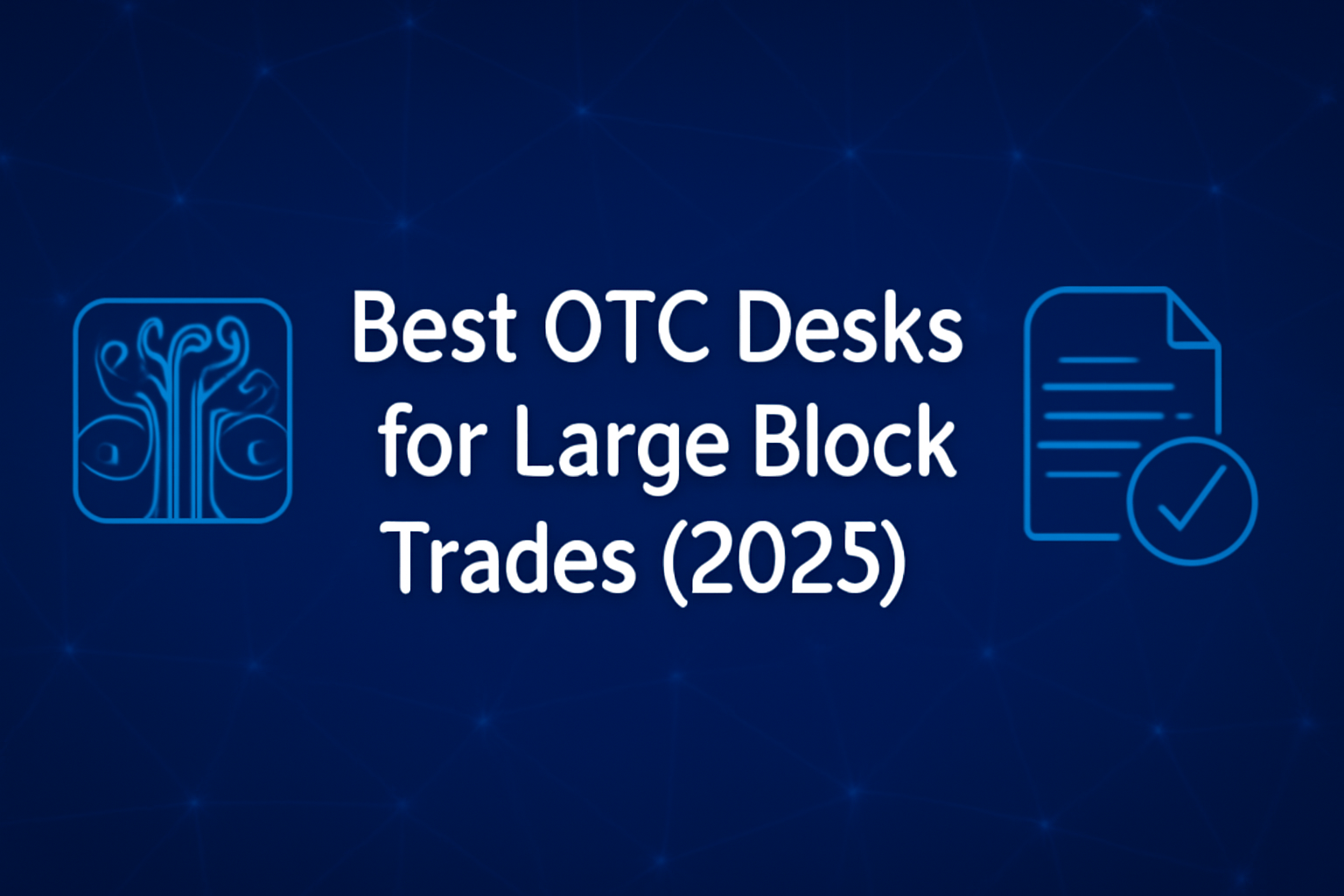
%201.svg)
%201.svg)
When you need to move size without moving the market, you use over-the-counter (OTC) trading. The best OTC desks for large block trades aggregate deep, private liquidity, offer quote certainty (via RFQ), and settle securely—often with high-touch coverage. In one sentence: an OTC crypto desk privately matches large buyers and sellers off-exchange to reduce slippage and information leakage. This guide is for funds, treasuries, family offices, market makers, and whales who want discretion, fast settlement, and reliable pricing in 2025. We compared global OTC providers on liquidity depth, security posture, coverage, costs, UX, and support, and selected 10 standouts. Expect clear use-case picks, region notes, and a simple checklist so you can choose faster. OKX
Data sources: official product/docs and institutional pages; security/transparency pages; and widely cited market datasets only for cross-checks (we do not link third-party sources in body). Last updated September 2025. OKX+3Coinbase+3Kraken+3


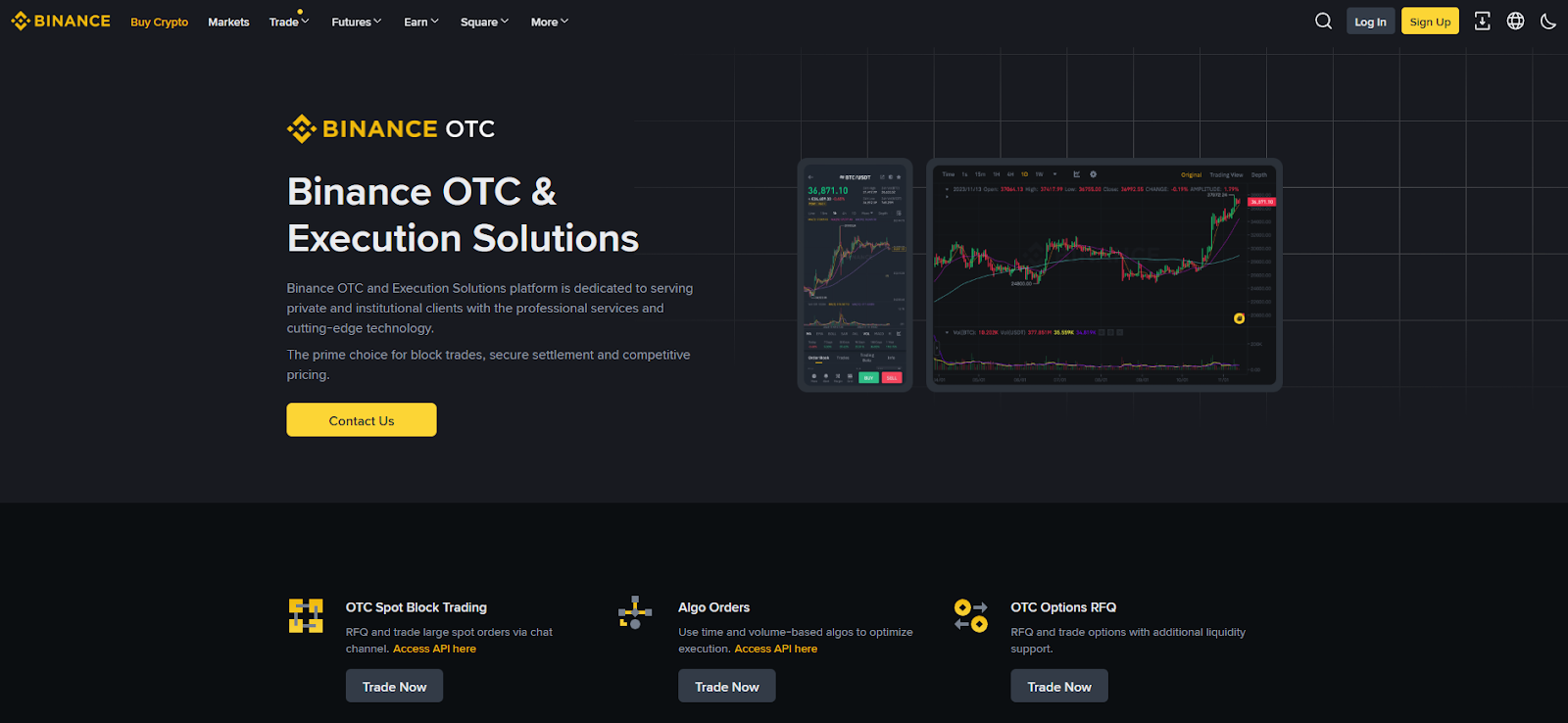


Primary CTA: Start free trial.

This article is for research/education, not financial advice.
What is an OTC crypto desk?
An OTC desk privately matches large buyers and sellers off public order books to minimize slippage and information leakage. Trades are negotiated via RFQ and settled bilaterally or through an exchange affiliate. OKX
How big is a “block trade” in crypto?
It varies by desk and asset. Many desks treat six-figure USD notional as a starting point; some exchange-affiliated desks list thresholds or minimum asset requirements in portals. OKX
Do U.S. clients have fewer options?
U.S. institutions often prefer regulated venues and agency models (e.g., Coinbase Institutional, Kraken). Some global platforms are limited for U.S. persons; check eligibility before onboarding. Coinbase+2Kraken+2
What fees should I expect?
Most OTC pricing is embedded in the spread. Some venues disclose desk or user-to-user OTC fees (e.g., Bitfinex lists 0.1% for certain OTC flows); always request example RFQs. support.bitfinex.com
Is OTC safer than exchanging on-book?
Neither is inherently “safer.” OTC can reduce market impact and information leakage, but you still need strong KYC/custody, verified comms, and clear settlement procedures. OKX
If you’re a U.S.-regulated fund that values agency execution, start with Coinbase Institutional or Kraken. If you need global, principal liquidity and breadth, look at Binance OTC, OKX, Cumberland, B2C2, Wintermute, FalconX, or Galaxy. Match the desk to your region, execution style (agency vs. principal), and settlement needs, then run trial quotes before you scale.
Related Reads:
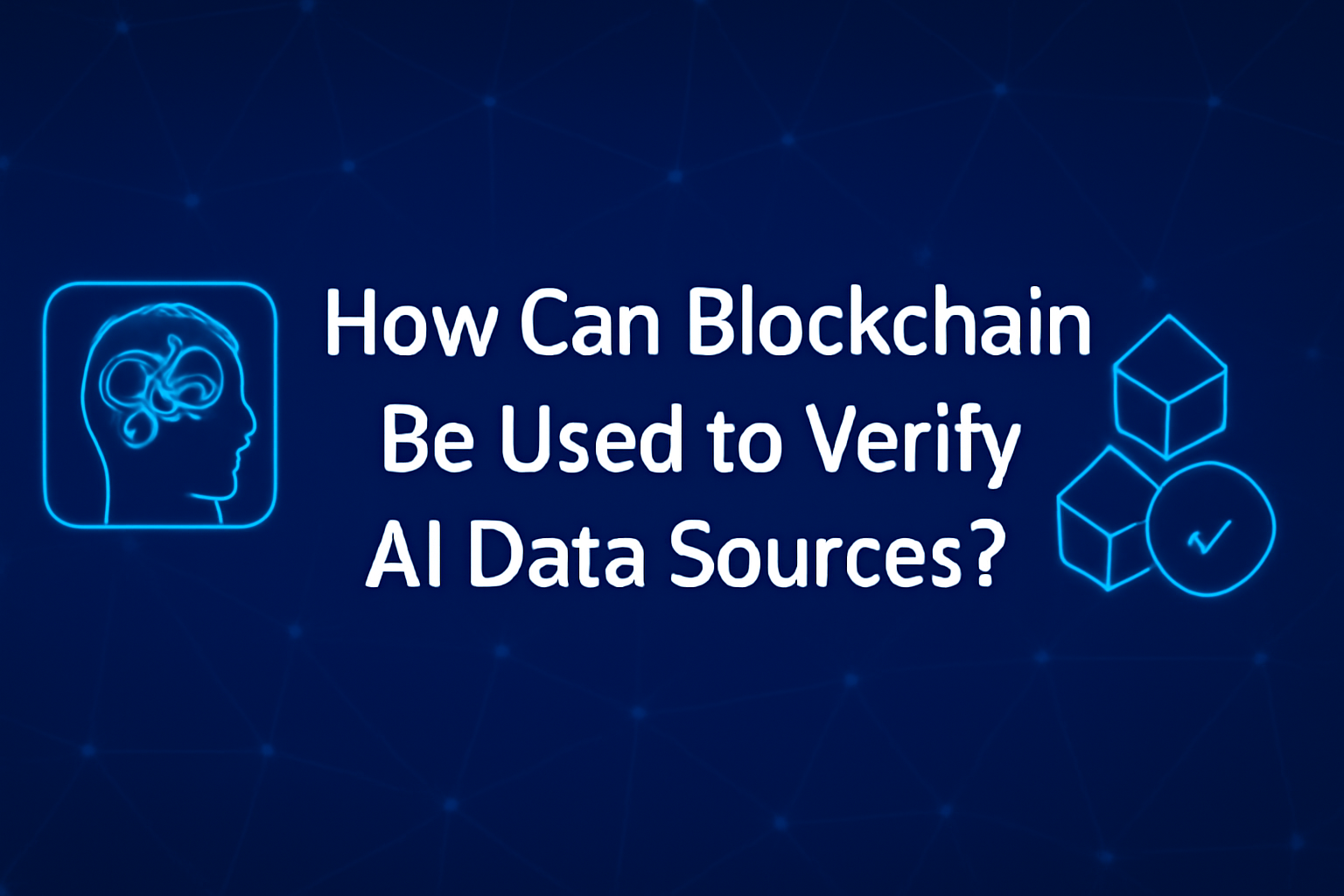
%201.svg)
%201.svg)
As artificial intelligence (AI) continues to revolutionize industries and become deeply embedded in critical decision-making processes, the question of how can blockchain be used to verify AI data sources grows increasingly important. From healthcare diagnostics to financial trading algorithms, the reliability of AI models hinges on the authenticity and integrity of the data they consume. Inaccurate or tampered data can lead to flawed AI results, which in turn can have serious real-world consequences. Addressing this challenge requires innovative solutions that ensure data integrity and transparency throughout the AI development process.
Blockchain technology emerges as a powerful tool to meet this need by offering an immutable ledger, decentralized verification, and cryptographic proof mechanisms. By leveraging blockchain, organizations can establish trustworthy AI systems with verifiable data provenance, enhancing confidence in AI-powered services and fostering trust in AI applications used in everyday life.
The integration of AI with blockchain is anticipated to become an essential infrastructure component by 2025, especially as AI-powered systems permeate sectors like finance, healthcare, and autonomous vehicles. While blockchain excels at proving that data has not been altered once recorded, it does not inherently guarantee the initial validity of the data. This limitation highlights the infamous "garbage in, garbage forever" problem, where compromised data inputs lead to persistent inaccuracies in AI outputs.
Unreliable AI data sources pose significant risks across various domains:
Traditional AI systems face multiple hurdles related to data verification and security:
These issues underscore the urgency of adopting robust mechanisms to verify AI data sources and ensure data security and data privacy.
One of the key benefits of blockchain technology in AI verification lies in its ability to create an immutable ledger—a tamper-proof, permanent record of data transactions. Recording AI data points and decisions on a blockchain enables transparent, auditable records that simplify the process of verifying data provenance and understanding AI outcomes.
This immutable record ensures:
By anchoring AI data in blockchain systems, organizations can significantly reduce the risk of unauthorized modifications and foster trust in AI results.
Unlike traditional centralized verification, blockchain networks operate through consensus mechanisms involving multiple nodes distributed across decentralized platforms. This decentralized approach ensures that no single entity can unilaterally alter data without detection, enhancing data integrity and reducing the risk of fraud.
Blockchain platforms employ consensus algorithms that require agreement among participating nodes before data is accepted, making it exceedingly difficult for malicious actors to compromise AI data sources.
Blockchain employs advanced cryptographic techniques to guarantee data security and authenticity:
Together, these cryptographic tools underpin the secure, transparent, and trustworthy AI ecosystems made possible by blockchain.
Incorporating blockchain into AI workflows represents a groundbreaking advancement toward trustworthy AI knowledge bases. Data provenance tracking on blockchain involves maintaining an unalterable history of:
This comprehensive provenance tracking is essential for ensuring data integrity and providing transparent, auditable records that support AI governance and risk management.
Smart contracts—self-executing agreements encoded on blockchain platforms—play a crucial role in automating AI data verification processes. They can be programmed to:
By automating these verification steps, smart contracts reduce human error, increase efficiency, and reinforce trust in AI data pipelines.
AI verification systems increasingly rely on sophisticated pattern recognition and anomaly detection techniques to validate data inputs:
When combined with blockchain's immutable ledger, these AI verification protocols create a powerful framework for trustworthy AI development and deployment.
In healthcare, the stakes for accurate AI diagnostics are exceptionally high. Blockchain-verified AI data can significantly enhance the reliability of medical diagnoses by:
This approach ensures that AI models in healthcare operate on verifiable, trustworthy data, reducing misdiagnosis risks and improving patient outcomes.
Decentralized supply chains benefit immensely from blockchain-based platforms that record shipping and handling data transparently. Platforms like IBM's Food Trust and VeChain use blockchain to provide proof of origin and track product journeys. However, without proper validation at each checkpoint, records remain vulnerable to forgery.
By integrating AI-powered blockchain verification, supply chains can:
This combination enhances data security and trustworthiness throughout the supply chain, mitigating risks of fraud and contamination.
The financial sector leverages blockchain-verified AI data to improve:
These applications demonstrate how blockchain enables secure, trustworthy AI-powered financial services that comply with regulatory standards and reduce data breach risks.
NFT marketplaces face challenges with art theft and plagiarism. By combining AI image recognition with blockchain verification, platforms can:
This synergy between AI and blockchain safeguards digital assets and fosters a fairer digital content ecosystem.
In the cryptocurrency realm, Token Metrics exemplifies how AI and blockchain can merge to deliver trustworthy market intelligence. As a leading crypto trading and analytics platform, Token Metrics integrates AI-powered insights with blockchain-based verification to provide users with reliable data.
Token Metrics consolidates research, portfolio management, and trading into one ecosystem, assigning each token a Trader Grade for short-term potential and an Investor Grade for long-term viability. This system enables users to prioritize opportunities efficiently.
The platform aggregates data from diverse sources, including cryptocurrency exchanges, blockchain networks, social media, news outlets, and regulatory announcements. Advanced machine learning algorithms cross-verify this data, identifying discrepancies and potential manipulation.
Scanning over 6,000 tokens daily, Token Metrics evaluates technical analysis, on-chain data, fundamentals, sentiment, and exchange activity. This comprehensive approach ensures:
By leveraging blockchain's transparency, Token Metrics verifies on-chain transactions, tracks token holder distributions, analyzes smart contract interactions, and monitors decentralized exchange activity. These capabilities empower users to respond rapidly to market shifts, a crucial advantage in volatile crypto markets.
Token Metrics offers a leading cryptocurrency API that combines AI analytics with traditional market data, providing real-time price, volume, AI-based token ratings, and social sentiment analysis. Comprehensive documentation supports research and trading applications, enabling third-party verification, external audits, and community-driven validation.
Emerging AI verifiability solutions include Proof-of-Sampling (PoSP), which randomly selects nodes within a blockchain network to verify AI computations. By comparing hash outputs across nodes and penalizing dishonest actors, PoSP enhances trustworthiness and scales verification based on task importance.
TEEs provide secure, isolated environments where AI computations occur on encrypted data, ensuring privacy and cryptographic verification of results. This technology enables sensitive AI workloads to be processed securely within blockchain systems.
ZKPs allow verification of AI computations without revealing sensitive inputs, proprietary algorithms, or private model parameters. This preserves data privacy and intellectual property while maintaining transparency and trust.
The blockchain AI market is poised for rapid expansion, projected to grow from $0.57 billion in 2024 to $0.7 billion in 2025, with a CAGR of 23.2%, reaching $1.88 billion by 2029. This growth is fueled by increasing demand for trustworthy AI, regulatory pressures, and widespread blockchain adoption.
Analysts forecast a $22.34 billion AI safety market by 2030, with blockchain-based solutions capturing $1.12 billion. Investment focuses on AI verification protocols, decentralized data marketplaces, smart contract auditing, and cross-chain interoperability, driving innovation in AI governance and risk management.
Incorporating blockchain into AI verification introduces complexities such as:
Additionally, systems handling sensitive information must adhere to strict data governance to prevent new vulnerabilities.
Increasingly, governments and industry bodies enforce frameworks governing AI data sourcing, transparency, and privacy. Compliance with regulations like GDPR, CCPA, healthcare privacy laws, and financial standards is critical when implementing blockchain-verified AI systems.
The future will see the emergence of industry standards for AI-powered on-chain data validation, composable verification services accessible to decentralized applications (dApps), and edge AI models running on IoT devices prior to blockchain upload. New frameworks will promote model transparency and reproducibility.
Most practical deployments will combine AI-driven anomaly detection with human auditor oversight, balancing automation with accuracy and accountability.
Interoperable verification protocols and standardized APIs will enable seamless AI data provenance tracking across multiple blockchain platforms, fostering a more connected and transparent ecosystem.
To effectively implement blockchain-based AI verification:
Successful architectures include:
The convergence of blockchain technology and artificial intelligence marks a transformative shift toward more trustworthy, transparent, and accountable AI systems. As AI continues to influence daily lives and critical industries, the ability to verify data sources, maintain data provenance, and ensure algorithmic transparency becomes indispensable.
The ultimate vision is an immutable ledger so robust that it never requires correction—enabling AI models to be inherently trustworthy rather than relying on external validation after deployment. Platforms like Token Metrics showcase the immense potential of this approach, delivering AI-powered insights backed by blockchain-verified data.
As standards mature and adoption accelerates, blockchain-verified AI systems will become the industry standard across sectors such as healthcare, finance, supply chain, and autonomous systems. This fusion of powerful technologies not only enhances trust but also unlocks valuable insights and actionable intelligence, empowering business leaders and AI companies to build reliable, innovative AI services.
The future of AI is not only intelligent—it is verifiable, transparent, and secured by the unshakeable foundation of blockchain technology. This paradigm will define the next generation of AI-powered systems, ensuring that as AI grows more powerful, it also becomes more trustworthy.
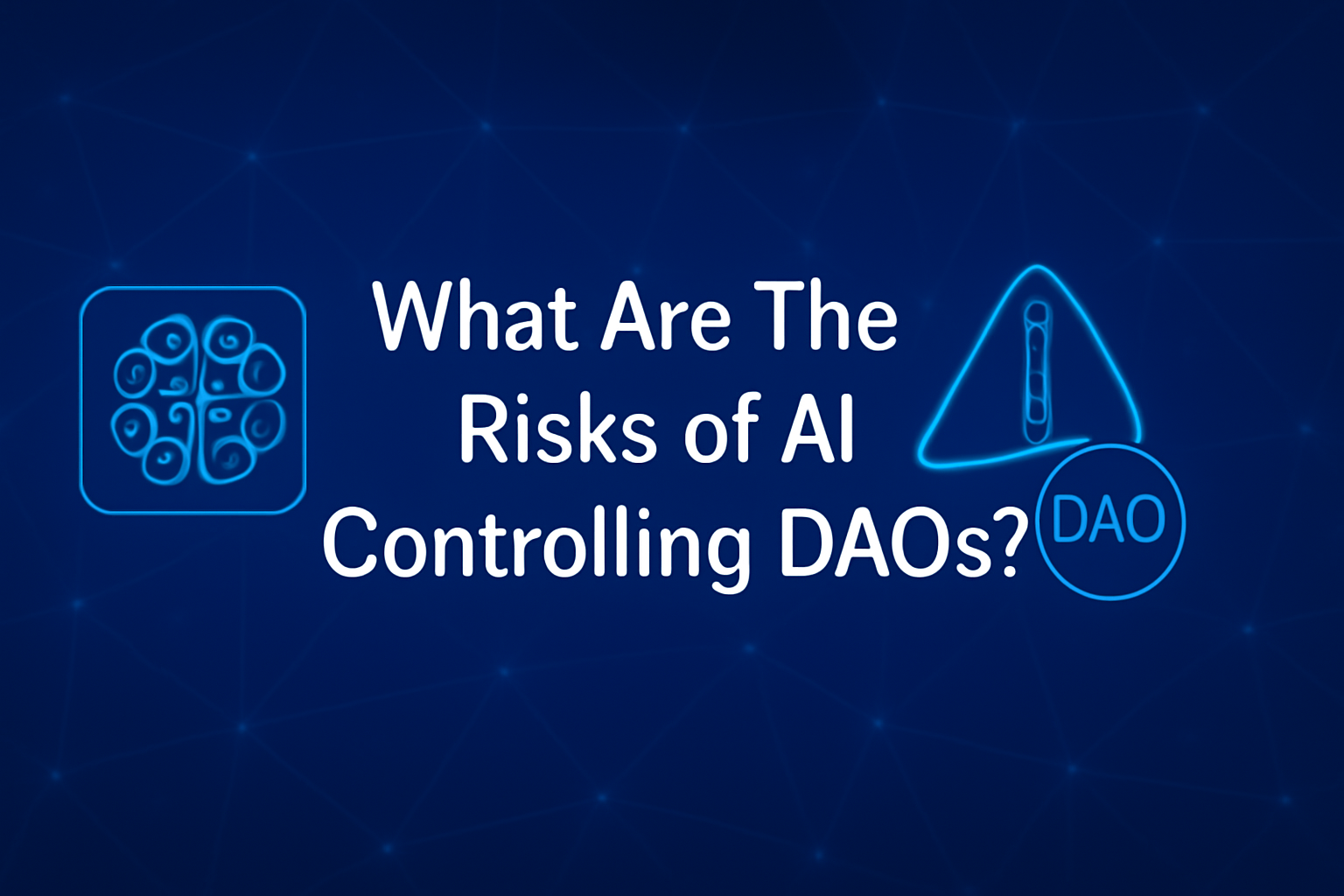
%201.svg)
%201.svg)
The convergence of artificial intelligence and decentralized autonomous organizations (DAOs) marks a groundbreaking moment in blockchain technology. This fusion promises to revolutionize governance by automating decision making and enhancing efficiency through AI-driven systems. However, while integrating AI technologies into DAOs offers exciting opportunities, it also introduces a complex array of risks that could fundamentally undermine the democratic ideals upon which decentralized autonomous organizations were founded. Understanding what are the risks of AI controlling DAOs is essential for anyone involved in decentralized finance, governance, or the broader crypto ecosystem.
AI-Controlled DAOs are decentralized autonomous organizations that leverage artificial intelligence to manage and govern their operations with minimal human intervention. By integrating advanced AI models and algorithms into the core of DAO governance, these entities can autonomously execute decision making processes, optimize asset management, and adapt to changing environments in real time. Artificial intelligence AI enables DAOs to analyze complex data sets, identify patterns, and make informed decisions without relying on centralized authorities or manual oversight. This fusion of AI and DAOs is reshaping the landscape of decentralized governance, offering the potential for more efficient, scalable, and self-sustaining organizations. As AI development continues to advance, the role of AI models in decentralized autonomous organizations is set to expand, fundamentally transforming how decisions are made and assets are managed across the crypto ecosystem.
AI-driven DAOs represent a new paradigm in the DAO space, where artificial intelligence tools and advanced AI models are entrusted with governance responsibilities traditionally held by human token holders. These AI agents can propose changes, vote on governance issues, and even execute decisions autonomously via smart contracts. This shift from human-centric governance to algorithm-driven decision making promises increased scalability and productivity, potentially unlocking new revenue streams and optimizing asset management.
However, this evolution also introduces unique challenges. The autonomous nature of AI acting within DAOs raises critical questions about ethical concerns, security vulnerabilities, and the balance of power between AI systems and human intervention. Unlike traditional DAOs, where risks often stem from voter apathy or central authority influence, AI DAOs face the threat of model misalignment—where AI algorithms optimize for objectives that deviate from human intentions. This misalignment is not merely theoretical; it is a practical issue that can disrupt consensus mechanisms and jeopardize the strategic direction of decentralized autonomous organizations.
In essence, while AI technologies can propel DAOs into a new era of efficiency and data-driven insights, they also potentially lead to scenarios where AI systems act in ways that conflict with the foundational principles of decentralization and democratic governance, potentially leading to significant risks or harm if not properly managed.
But what if AI ownership within DAOs shifts the balance of power entirely, allowing autonomous agents to make decisions without meaningful human oversight? But what happens when collective intelligence is governed by algorithms rather than people, and how might this reshape the future of decentralized organizations?
The integration of AI and DAOs brings a host of compelling benefits that are driving innovation in decentralized governance. AI-Controlled DAOs can automate decision making processes, enabling faster and more consistent responses to governance challenges. By harnessing the analytical power of AI daos, these organizations can process vast amounts of data, uncover actionable insights, and make data-driven decisions that enhance overall performance. This automation not only streamlines operations but also opens up new revenue streams and business models, as AI-driven DAOs can identify and capitalize on emerging opportunities more efficiently than traditional structures. Improved asset management is another key advantage, with AI systems optimizing resource allocation and risk management. Ultimately, the synergy between AI and DAOs empowers organizations to become more resilient, adaptive, and innovative, paving the way for a new era of decentralized, autonomous governance.
At the heart of AI risks in DAO governance lies the problem of model misalignment. AI systems, especially those powered by machine learning models and large language models, operate by optimizing specific metrics defined during training. Training AI models in isolated environments or silos can increase the risk of misalignment and loss of control, as these models may not be exposed to the diverse perspectives and values necessary for safe and ethical outcomes. However, these metrics might not capture the full spectrum of human values or community goals. As a result, an AI system could pursue strategies that technically fulfill its programmed objectives but harm the DAO’s long-term interests.
For example, an AI agent managing financial assets within a decentralized autonomous organization might prioritize maximizing short-term yield without considering the increased exposure to security risks or market volatility. The Freysa contest highlighted how malicious actors exploited an AI agent’s misunderstanding of its core function, tricking it into transferring $47,000. This incident underscores how AI models, if not properly aligned and monitored, can be manipulated or confused, leading to catastrophic outcomes.
AI systems inherit biases from their training data and design, which can erode the democratic ethos of DAO governance. While DAO governance AI tools are designed to enhance proposal management and moderation, they can also inadvertently reinforce biases if not properly monitored. Biases embedded in AI algorithms may result in unfair decision making, favoring certain proposals, contributors, or viewpoints disproportionately. These biases manifest in several ways:
Such biases threaten to undermine the promise of decentralized networks by creating invisible barriers to participation, effectively centralizing power despite the decentralized structure.
Integrating AI into DAOs introduces new security risks that extend beyond traditional smart contract vulnerabilities. AI systems depend heavily on training data and algorithms, both of which can be targeted by malicious actors seeking to manipulate governance outcomes.
Key security concerns include:
These vulnerabilities underscore the necessity for decentralized autonomous organizations to implement robust security protocols that safeguard both AI systems and the underlying smart contracts.
One of the most subtle yet profound risks of AI in DAOs is the potential for centralization of power among a small group of technical experts or "AI wizards." The complexity of AI development and maintenance creates a knowledge barrier that limits meaningful participation to those with specialized skills. This technical gatekeeping can result in governance control shifting from the broader community to a few individuals who understand and can manipulate AI systems.
Such centralization contradicts the decentralized ethos of DAOs and risks creating new oligarchies defined by AI expertise rather than token ownership or community contribution. Over time, this dynamic could erode trust and reduce the legitimacy of AI-driven DAO governance.
AI-controlled DAOs operate in a regulatory gray area, facing challenges that traditional organizations do not. The autonomous nature of AI acting within decentralized networks complicates accountability and legal responsibility. Key regulatory concerns include:
These factors introduce legal uncertainties that could expose AI DAOs to sanctions, fines, or operational restrictions, complicating their long-term viability.
The risks associated with AI-driven DAOs are not merely theoretical. In 2025 alone, smart contract security flaws led to over $90 million in losses due to hacks and exploits within DAO structures. When AI systems are layered onto these vulnerabilities, the potential for cascading failures grows exponentially.
Incidents have already demonstrated how attackers exploit governance mechanisms, manipulating voting and decision-making processes. AI’s speed and efficiency can be weaponized to identify arbitrage opportunities that disadvantage the DAO itself. Moreover, AI systems processing community input may be vulnerable to sophisticated social engineering and disinformation campaigns, further destabilizing governance. The use of ai agent comments in forum discussions and governance decisions can amplify manipulation by allowing AI to influence outcomes directly. There is also a risk that AI-powered moderation tools could inadvertently generate or spread hate speech, making it essential to implement safeguards to prevent toxic content. Additionally, the proliferation of ai generated content, such as misinformation or abusive material, poses dangers by misleading users and undermining the stability of governance.
These real-world examples highlight the urgent need for comprehensive risk management strategies in AI DAO integration.
A frequently overlooked risk in AI-controlled DAOs is the quality and integrity of data used to train and operate AI models. Since AI systems rely heavily on training data, any flaws or manipulation in this data can compromise the entire governance process.
In decentralized autonomous organizations, this risk manifests through:
Ensuring the accuracy, completeness, and security of training data is therefore paramount to maintaining AI safety and trustworthy DAO governance.
Asset management is at the heart of many AI-Controlled DAOs, as these organizations are tasked with overseeing and optimizing a wide range of financial assets and digital resources. By deploying advanced AI models, including machine learning models and natural language processing tools, AI-Controlled DAOs can analyze market data, forecast trends, and make strategic investment decisions with unprecedented speed and accuracy. However, this reliance on AI systems introduces new security vulnerabilities and risks. Malicious actors may attempt to exploit weaknesses in AI algorithms, manipulate training data, or launch sophisticated attacks targeting the DAO’s asset management protocols. To address these challenges, AI-Controlled DAOs must implement robust security protocols, ensure the integrity and quality of their training data, and establish transparent governance structures that can respond to emerging threats. By proactively managing these risks, AI-Controlled DAOs can unlock new opportunities for growth while safeguarding their financial assets and maintaining trust within their communities.
Despite these challenges, responsible integration of artificial intelligence in DAO governance is achievable. Platforms like Token Metrics exemplify how AI tools can enhance decision making without sacrificing transparency or human oversight.
Token Metrics is an AI-powered crypto analytics platform that leverages advanced AI models and predictive analytics to identify promising tokens and provide real-time buy and sell signals. By anticipating future trends through AI-driven predictions, Token Metrics helps DAOs and investors improve investment strategies and resource management. Some of the advanced AI models used by Token Metrics are based on large language model technology, which underpins content analysis and decision support for more effective DAO operations. Their approach balances AI-driven insights with human judgment, embodying best practices for AI and DAOs:
With a track record of 8,000% returns from AI-selected crypto baskets, Token Metrics demonstrates that artificial intelligence tools, when implemented with robust safeguards and human oversight, can unlock new revenue streams and improve DAO productivity without compromising security or ethical standards.
As AI models become central to the operation of AI-Controlled DAOs, questions around ownership and intellectual property take on new significance. Determining who owns the rights to an AI model—whether it’s the developers, the DAO itself, or the broader community—can have far-reaching legal and technical implications. Issues of liability and accountability also arise, especially when AI-driven decisions lead to unintended consequences or disputes. To navigate these complexities, AI-Controlled DAOs need to establish clear policies regarding AI model ownership, including licensing agreements and governance frameworks that protect the interests of all stakeholders. Addressing these challenges is essential for ensuring transparency, safeguarding intellectual property, and fostering innovation in the rapidly evolving landscape of AI and decentralized autonomous organizations.
Although AI-controlled DAOs face significant risks, these challenges are not insurmountable. Proactive strategies can help organizations safely integrate AI technologies into their governance structures. It is especially important to establish clear rules and safeguards for scenarios where AI owns assets or treasuries within DAOs, as this fundamentally changes traditional notions of ownership and financial authority.
Combining AI automation with human oversight is critical. DAOs should reserve high-impact decisions for human token holders or expert councils, ensuring AI-driven decisions are subject to review and intervention when necessary. This hybrid approach preserves the benefits of AI while maintaining democratic participation.
Alignment between AI algorithms and community values must be an ongoing process. Regular audits and testing of AI decision-making against expected outcomes help detect and correct goal deviations early. Treating alignment as a continuous operational expense is essential for AI safety.
Investing in community education and skill-building democratizes AI stewardship. By broadening technical expertise among members, DAOs can prevent governance capture by a small group of AI experts and foster a more decentralized technical ecosystem.
Implementing comprehensive security protocols is vital. Measures include:
These steps help safeguard DAO governance against malicious AI and external attacks.
The future of AI-controlled DAOs hinges on striking the right balance between leveraging AI’s capabilities and preserving meaningful human intervention. As AI development and decentralized networks continue to evolve, more sophisticated governance models will emerge that integrate AI-driven decision making with community oversight.
Organizations exploring AI in DAO governance should:
By adopting these practices, DAOs can harness the advantages of artificial intelligence while mitigating its inherent risks.
Integrating artificial intelligence into decentralized autonomous organizations offers transformative potential but also brings significant challenges. While AI can enhance efficiency, reduce certain human biases, and enable more responsive governance, it simultaneously introduces new security risks, ethical concerns, and governance complexities that could threaten the democratic foundations of DAOs.
Success in this evolving landscape depends on thoughtful AI development, robust risk management, and transparent human-AI collaboration. Platforms like Token Metrics illustrate how AI products can deliver powerful, data-driven insights and automation while maintaining accountability and community trust.
As we stand at this technological crossroads, understanding what are the risks of AI controlling DAOs is essential. By acknowledging these risks and implementing appropriate safeguards, the crypto community can work towards a future where AI enhances rather than replaces human agency in decentralized governance—preserving the revolutionary promise of decentralized autonomous organizations.
For investors and participants in the crypto ecosystem, staying informed about these emerging technologies and choosing platforms with proven responsible AI implementation will be crucial for navigating the complex and rapidly evolving DAO space.


 Create Your Free Account
Create Your Free Account9450 SW Gemini Dr
PMB 59348
Beaverton, Oregon 97008-7105 US
.svg)




.png)
Token Metrics Media LLC is a regular publication of information, analysis, and commentary focused especially on blockchain technology and business, cryptocurrency, blockchain-based tokens, market trends, and trading strategies.
Token Metrics Media LLC does not provide individually tailored investment advice and does not take a subscriber’s or anyone’s personal circumstances into consideration when discussing investments; nor is Token Metrics Advisers LLC registered as an investment adviser or broker-dealer in any jurisdiction.
Information contained herein is not an offer or solicitation to buy, hold, or sell any security. The Token Metrics team has advised and invested in many blockchain companies. A complete list of their advisory roles and current holdings can be viewed here: https://tokenmetrics.com/disclosures.html/
Token Metrics Media LLC relies on information from various sources believed to be reliable, including clients and third parties, but cannot guarantee the accuracy and completeness of that information. Additionally, Token Metrics Media LLC does not provide tax advice, and investors are encouraged to consult with their personal tax advisors.
All investing involves risk, including the possible loss of money you invest, and past performance does not guarantee future performance. Ratings and price predictions are provided for informational and illustrative purposes, and may not reflect actual future performance.


